The Impact of Company Brand Culture On Driving Performance and Increasing Sales
/2 Comments/in Brand Culture, Brand Experience, Brand Innovation, Brand Loyalty, Brand Positioning, Brand Profiling & Positioning, Brand Refresh, Brand Relaunch, Brand Revitalisation, Brand Values, Rebranding /by Lorraine CarterMost leaders and employees would view company brand culture as a crucial part of job performance and satisfaction coupled with great customer service, yet for so many brands it remains an elusive concept.
We all know intuitively that a bad company culture produces bad results and there are plenty of statistics to back this up. One Columbia University study shows that the probability of job turnover when a brand’s company culture is poor is 48.4%, compared to just 13.9% when the brand culture is perceived as a good one.[1]
In fact, good corporate brand culture fundamentally drives financial performance as evidenced by the research published in the book ‘Corporate Culture and Performance’ by HBS Professor James Heskett and Kotter International[2]
| GROWTH | Average Increase for Twelve Firms with Performance-Enhancing Cultures | Average Increase for Twenty Firms without Performance-Enhancing Cultures |
| Revenue Growth | 682% | 166% |
| Employment Growth | 282% | 36% |
| Stock Price Growth | 901% | 74% |
| Net Income Growth | 756% | 1% |
“Great companies that build an enduring brand have an emotional relationship with customers that has no barrier. And that emotional relationship is the most important characteristic, which is trust.”
Howard Schultz, Starbucks
Culture matters because it’s about transparency, company behaviour, what you stand for, who you are. Brand Culture is how you convey, share, and translate that into your brand. It’s what every employee believes, does, and lives to express that culture.
Brand culture is driven by the fundamentals of your brand profiling i.e. what your brand stands for, it’s personality, mission, vision, values, purpose and way of doing things.
It’s about building a relationship between your culture, which may be developed over time but should ideally be guided from the top, the founder, owner or CEO — the visionary behind the brand — and your brand itself in terms of its personality, how it does things, the customer experience it creates and what it stands for. How you develop them to create a strong positive and distinctive brand experience.
Related: CEO Brand Leadership, How Vision Drives Brand Growth
There are also bad cultures within businesses and organisations which are not positive brand experiences. These poor brand cultures undermine performance, productivity, the whole perception of the organisation, the brand and negatively impact sales.
Our experience working with many different companies and organisations across diverse sectors clearly illustrates that it’s not that they haven’t considered company brand culture, it’s that developing and implementing something perceived to be so abstract can be difficult.
Related: Top 10 Brands for Customer Experience and What You Can Learn From Them
Because of this apparent client challenge we’ve pulled together some tangible ways you can start working on and developing your brand culture together with case studies from worldwide brands to show you ‘brand culture’ in action in the ‘real world’.
They’re brands who, like us, understand that building culture is not about placing a ping-pong table in a rec room, it starts with strong brand values that respect your employees and customers alike.
12 Ways To Improve Your Company’s Brand Culture so You Increase Performance and Grow Sales
1. Don’t be Afraid to Mix Marketing with People
Based in Kansas and proud of its community roots, CornerBank, now part of RCB Bank, describes itself as the bank that is “on your corner and in your corner”.[3] Their approach to culture and marketing lies in people, something which RCB Bank is trying to emulate since their merger last year.

Image via CornerBank
CornerBank practised what they preached by combining the head of HR and the head of marketing into one role because their “people are their best marketing tool”.[4] While it’s undeniably an unorthodox way of structuring a company, in doing so, they put faith in their staff, and most importantly, their staff’s commitment to upholding those community roots. It’s a company that looks out for the little guy and ensures that its employees identify strongly with this.
2. Bridge the Gap Between Employee and Customer
With a client retention rate of a near-perfect 97.8%, bank and insurance provider, USAA is one of the most reputable and trusted brands in America.[5]
They have a unique proposition in that the vast majority of their customers are active or retired US military. No one knows their customer better than USAA and the company instils this in their employees by training them in the experiences of a soldier.[6]
This works in two ways. Firstly, for company culture, it gives employees insights that help them do their job better, which improves job satisfaction, and challenges them in the right way. And secondly, it shows customers that their experiences are genuinely important to the brand as a whole, but also that the people who they reach out to for service are much better equipped to deal with their situation. For soldiers trying to do their banking from war zones, that is often a pretty unique one.
3. Foster Fun and Creativity
When you think of best practice company culture, tech companies tend to come to mind. They seem to understand the important connection between having fun and innovating. Squarespace embodies many of the principles of best practice company culture – an attractive office space, very few levels of management, celebrations, downtime and flexibility.
What’s important here is that these practices stem from the company’s respect for its employees. This is the approach we take when we are working with clients. Downtime and flexibility show employees that they are respected enough to get on with their job and exercise a certain amount of autonomy.
Related: Use Humour in Branding to Create Strong Emotional Bonds so You Increase Sales
The fun aspects of this company’s culture are layered on top of this to let employees know that their work is appreciated. This two-pronged approach ensures that your company brand culture is engrained as a real living experience for everyone and not just lip service.
4. Offer Flexibility
Flextime is not a particularly new concept, and you’ll find it especially prevalent in public service organisations and progressive companies in western countries. Because of this, extensive research has been conducted to measure the value of offering this to your employees.
A survey conducted by The Alternative Board (TAB), an international provider of executive peer advisory boards, of hundreds of business owners, found that business owners who thought that their company culture was ‘strong’, also offered their employees flexible conditions, particularly in terms of time and remotely working.[7] We tend to find that when workplaces concentrate on results, project completion, and quality of work, the perceived ‘drudgery’ of the 9-5 work culture is eliminated, and employees feel part of something bigger which engenders a greater sense of job satisfaction.
Medium-sized British activewear company, Sweaty Betty, embodies these principles by using open communication and showing that they understand their employees have life commitments in addition to their work ones. “We trust our team and operate on a flexi-hour policy,” says Jessica Howden, people and events coordinator. “If a team member would rather leave earlier in the afternoon because of a long commute, they can start earlier in the morning. Our working hours are not set in stone.”[8]
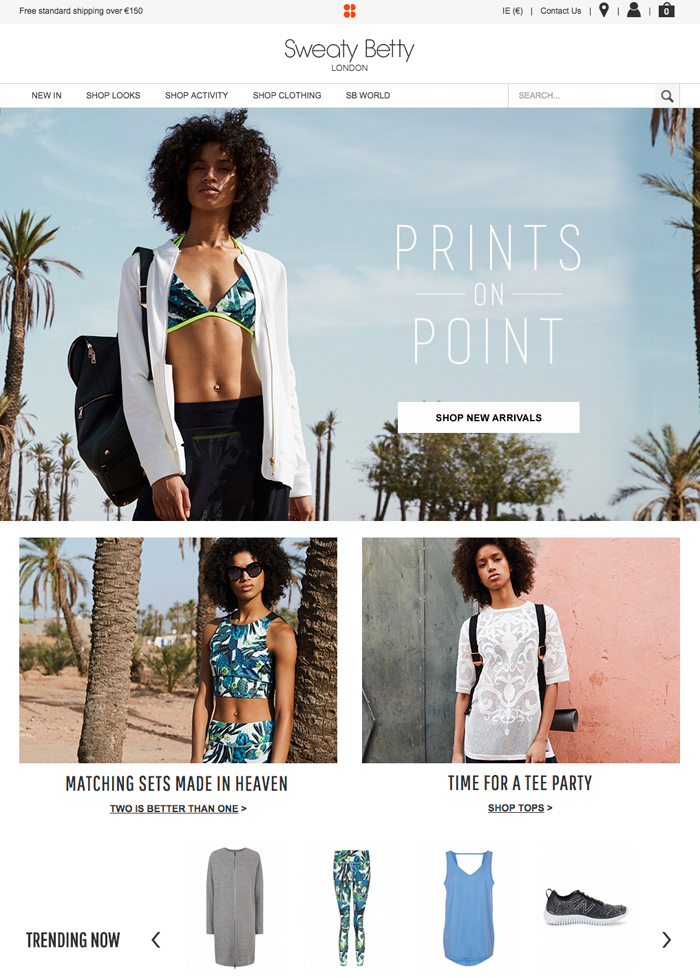
Image via Sweaty Betty
5. Build Brand Relationships to Create Community
Ask any social scientist, the key to happiness among employees in a workplace is when they feel like they are part of something bigger that makes a difference. Apple and Nike exhibited this in their September 2016 keynote where they teamed up to introduce the second-generation Apple watch. This is a watch that allows people to be part of two tribes – the Apple tribe, and the Nike Running Club tribe.
Aligning with another brand that commands respect and complements your brand values and positioning promotes inclusivity in your workplace and makes your employees feel like they are part of something larger than themselves. It also strengthens your brand in the mind of your customer and leads to commercial growth – advocates of one brand will be more likely to become advocates of the other when they are aligned.
When we work with companies to identify co-branding opportunities, having a strong brand culture or value fit is essential. Some of the most effective brand collaborations and alignments are not even necessarily in the same industry. This can yield great results for SMEs where the primary focus is to stand out, increase brand awareness with sales and reach new audiences.
Related: Co-Branding, 13 Tips for Growing Your Brand Through Strategic Partnerships
6. Hire ‘Your’ People
Traditional recruitment is generally based on skills and experience. Our approach to recruitment for your brand is to ascertain a baseline level of aptitude that you would consider mandatory, and place more emphasis on finding a suitable fit with your organisations brand culture.
Recruitment companies, such as New Zealand-based company, Weirdly, take an innovative approach to recruitment using a series of tactics to assess a potential employees culture fit before they even get to the interview phase. In doing this, you create a workplace where people feel a sense of belonging, as well as the crucial creation of an environment where ideas can be shared.
7. Employees as Brand Ambassadors
As we’ve mentioned, most companies will try to hire employees who reflect and embody their company’s values in some way. Increase engagement with your brand and create authentic communication by making it attractive for your employees to become brand ambassadors.
According to the 2016 Edelman Trust Barometer “Employees rank higher in public trust than a firm’s PR department, CEO, or Founder. 41% of us believe that employees are the most credible source of information regarding their business.”[9]
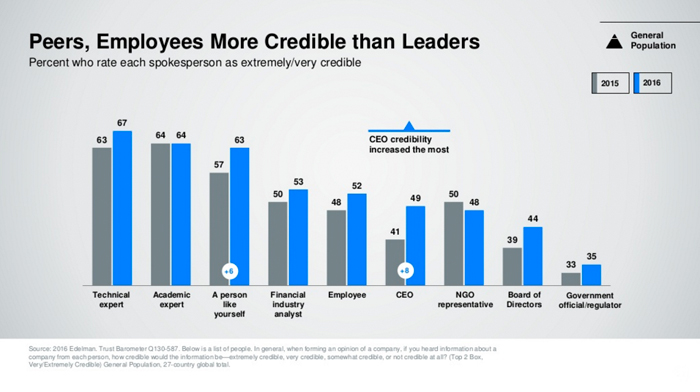
Image via Edelman Insights
We believe that this likely stems from the perception that employees are much more likely to voice their honesty, particularly if they are disgruntled. An employee that is openly endorsing a company is viewed as a trustworthy and reliable opinion. Social media is a great platform to try this on. Creating environments where employees feel compelled to share the goings-on of their workplace on their personal channels speaks volumes, and is a great place to start.
American-based retailer, Zappos, has an infamous reputation for its focus on employee culture. “At Zappos, we really view culture as our No. 1 priority. We decided that if we get the culture right, most of the stuff, like building a brand around delivering the very best customer service, will just take care of itself.” Tony Hsieh, CEO, Zappos–January 9th, 2010, The New York Times[10]
Related: Brand Sponsorships: The Best Brand Ambassadors Are Already On Your Payroll
8. Give Your Audience a Sneak Peek into Your Culture
In a similar way, don’t be afraid to shed a little light on how great your company is behind the scenes. Doing so increases your brand value with your customers and gives employees a public reason to feel proud of where they work. Your customers could also be your potential employees.
Just ensure that what you are posting accurately reflects your brand values as a company and how you want people to perceive it. ASOS is a great example of this – they use their Instagram account to provide sneak peeks into their workplace culture. It injects personality into the brand and shows that they value their employees.

Image via ASOS on Instagram
9. Remove Restrictive Hierarchies
Hierarchies are a particularly tricky area of company politics to navigate. We tend to look at hierarchies not from a ‘have them/don’t have them’ perspective, but rather explore why you have them, what purpose they serve and, most importantly, whether they are restrictive. Closed door policies can inhibit the flow of ideas and creates an ‘us and them’ culture, which is intimidating and often counter-productive.
While your brand needs a leadership team, and there will be things that the leadership team knows that employees aren’t privy to, there are ways to create an open and flexible environment.
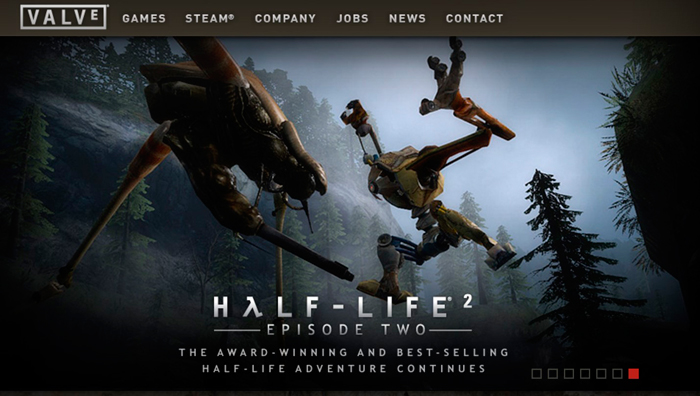
Image via Valve Software
SME, Valve Software[11], does this well – they have no managers, projects are started when an employee can group a team together, and performance management is conducted as peer review. As a result, Valve has experienced tremendous growth – something that would normally require rigidity to manage.
10. Make Your Employees Part of Your Brand Mission
Create an atmosphere where employees feel like they contribute to the outcome of your company or organisation. Environments where staff feel like they are part of something bigger than themselves have been constantly proven to be success-drivers. Results happen when everyone is invested.
So, how do you go about this? Our approach is to create a great brand and strategy communication from the top down. Internal communication should be tailored so that, no matter the structure of your company, each employee knows how they contribute to wider goals, and, most importantly, has a clear idea of what those wider goals are.
Including corporate social responsibility into part of your operations is a great way of tangibly showing both customers and employees that your company is committed to the greater good.
Relate: Brand CSR, The Business Case for Successful Branding and Social Good
Ice cream giant, Ben & Jerry’s, demonstrates that ethics are not just for the realms of small, niche enterprises by only using fair trade ingredients.[12] In strengthening their customer’s positive perception of them as a company, they increase employee morale, drive purchases, and ensure that their brand personality doesn’t fall into the trap of becoming disconnected with consumer’s needs.
Related: Personality Matters: Bringing Your Brand to Life to Grow Profits
11. Give your employees what they need
This is the proof point that your company is not just about placing that ping-pong table in the rec room. Showing employees that you value them and their lives as people, not just workers, vastly increases job satisfaction.
71% of staff at Goldman Sachs feel that they often or almost always receive great rewards, while 82% of American Express employees report that the company often or almost always provides needed training, fair promotions and personally challenging work.[13] While it’s not the glamorous, fun side of company brand culture, creating a base that ensures that your employees know they are valued through things such as child care, mentoring and health, can make a dramatic difference.
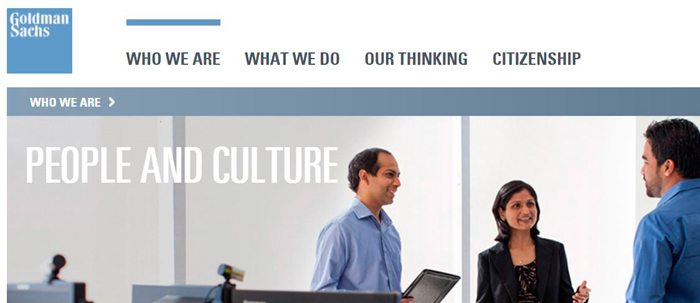
Image via Goldman Sachs
12. Create Autonomy
Career analyst, Dan Pink, has spent much of his own working career studying what it takes for employees to be motivated. It turns out, creating an environment where employees feel that they are the ‘masters of their own destiny’ is one of the most important aspects of employee happiness. This can be relatively easy to establish if the work is naturally project or campaign based, so thought should be given particularly to the roles where work is more constant and not as varied.
For instance, a Web Content Manager at an SME spends their day ensuring that the content is relevant, accurate and appropriate for the company. A company with a poor brand culture will treat this Content Manager as a worker, one who processes and publishes the team’s work, whereas a company with a great brand culture will instil autonomy in the Content Manager. They own the content space, feel comfortable providing advice and direction, and are looked to as the expert in that field. A small change, but one that makes a huge difference.
Related: Family Business Branding and The Secret Drivers to Brand Success
Brand culture integrates itself into every part of your company from the way customers perceive your company and trust you, which in turn has a massive impact on their likelihood to buy and become brand advocates, to your own employees’ sense of job satisfaction.
If you’re struggling to strongly develop your brand culture in order to improve your overall performance, growth and profitability, then a brand audit is a very useful tool to help you evaluate your areas of strength, weakness and potential innovation and growth.
Take a look at our brand audit programme called the Auditing Analysis Accelerator™. This online course takes you through all the key steps you need to consider in giving your brand a health check. It enables you to identify areas of strength, weakness and pinpoint new opportunities for innovation and growth. You can watch a free course preview here.

Audit your brand now so you can identify where and how to build your strong brand culture
Alternatively, if you’ve got a major challenge on your hands then perhaps a brand revitalization or refresh may be the most effective option to turn things around. Feel free to get in touch, we’d be delighted to help. Drop us a line to [email protected] or give us a call T: +353 1 8322724 (GMT hours 9:00-17:00).
Viewing your workplace as a mutually beneficial environment, one that adds value to both the employer, employee and customer is crucial to job satisfaction, role performance and customer satisfaction, which are what collectively drive growth and achieve strong commercial results.
There are so many ways that SMEs / SMBs can add value to their employees’ lives by providing them with the benefits and autonomy they need, to creating a fun and inviting environment that instils a sense of pride and appreciation. We can help you uncover and articulate your brand values, and most importantly, how to actually achieve them in your organisation in an authentic way that enhances your peoples’ lives while also increasing your profits.
Questions to consider
- Have you evaluated how you can improve your brand culture to attract and retain high performing talent so you can increase your brand awareness, market share and sales?
- When did you last give you brand a health check so you can identify areas of weakness, strength and where to innovate?
- Could you give some members of your team more autonomy to increase their motivation, performance and sense of fulfilment?
- Have you trained your staff and fully inducted them in what your brand stands for and what that means in a day-to-day actionable, living sense so you can improve their performance, brand alignment and the quality of the customer experience delivered?
- Is now the right time for a brand refresh so you can improve your brand culture, re-invigorate company morale and increase overall market impact and growth?
Want to refresh your brand but you’re not sure where to start to get a successful return on your investment?
Drop us a line or give us a call… we’re here to help!
If you want direction and support transforming your brand so it fully embraces changing trends and increases sales then the Persona Brand Building Blueprint™ Mastermind is the perfect fit for you.
This is a two-day brand building intensive shared with a small group of like-minded peers where you work on your brand with our leadership. In fact, over the two days, you reevaluate your brand, codify it and create your brand strategy from the ground up whether you’re revitalising an existing brand or creating a new one.
At the end of the two-day Persona Brand Building Blueprint™ Mastermind you leave with your fully documented brand strategy ready for implementation in your business or organisation.
If your team is larger and you’d like to include your full team’s participation in the Persona Brand Building Blueprint™ Mastermind then we also run in-house private client brand building intensive programmes too.
Ring us to discuss your brand building preferences
Just drop us a line to [email protected] or give us a call T: +353 1 8322724 (GMT 9:00 – 17:00) to discuss your preferences and we’ll develop your brand building intensive bespoke to your particular brand requirements so that you have your brand solution built to greatly enhance your brand culture and secure your future success.
[1] https://www.entrepreneur.com/article/238640
[2] https://www.forbes.com/sites/johnkotter/2011/02/10/does-corporate-culture-drive-financial-performance/#7fb4ea207e9e
[3] https://hbr.org/2010/09/brand-is-culture-culture-is-br
[4] https://hbr.org/2010/09/brand-is-culture-culture-is-br
[5] https://www.bloomberg.com/news/articles/2010-02-18/usaas-battle-plan
[6] https://hbr.org/2010/09/brand-is-culture-culture-is-br
[7] http://www.businessnewsdaily.com/5935-improve-company-culture.html
[8] http://www.telegraph.co.uk/sponsored/business/britains-healthiest-company/11848497/flexible-working-hours.html
[9] https://www.forbes.com/sites/williamarruda/2013/10/08/three-steps-for-transforming-employees-into-brand-ambassadors/#5f8f0e9e1040
[10] http://www.inc.com/ananya-bhattacharya/tony-hsieh-on-company-culture.html
[11] https://www.inc.com/david-burkus/how-this-company-runs-without-managers.html
[12] http://www.businessnewsdaily.com/4679-corporate-social-responsibility.html
[13] https://www.entrepreneur.com/article/245667
7 Ways A Brand Refresh Will Make You More Productive And Increase Sales
/0 Comments/in Brand Refresh, Brand Relaunch, Brand Relevance, Brand Revitalisation, Brand Strategy, Branding, Rebrand, Rebranding, Return On Investment, Revamped Design, Revitalized Design /by Lorraine CarterIt’s often human nature to resist change because persisting with the comfortingly familiar feels ‘safer’. Sadly the marketplace is littered with case studies and examples of once very successful brands now gone forever, often because their leaders didn’t implement the critical changes needed, together with a brand refresh, that were essential to ensuring a successful future.
“A Business That Doesn’t ChangeIs A Business That IsGoing To Die”Frank Perdue |
The most recent example of this kind of demise is Stuttafords, a 159-year icon leading department store in South Africa, which will permanently close its doors at the end of July 2017.[1]
Another example is Sears, America’s previously largest retailer. It was a mistake their leaders made to assume no one could overtake them, and yet both Walmart and Amazon have. Sears failed to adapt and as a result, in June 2017, closed yet another 72 stores.[2]
Related: How Do Challenger Brands Become Market Leaders?
Both Stuttafords and Sears could still be flourishing today if they had been more open to real change and the sad fact is, to quote Buckminster Fuller, “You never change things by fighting reality. To change something, build a new model that makes the existing model obsolete” so a well-timed brand refresh underpinned by a thorough brand audit could have resulted in a very different story for both.
In this article, we’ll uncover the 7 ways a brand refresh could have prevented the downfall of some of the world’s greatest companies, to make them more productive so they could have maintained and increased their sales.
What Is The Meaning Of “Brand Refresh”?
A brand refresh means giving your core proposition a health check, using a brand audit, to identify where weaknesses, strengths and opportunities for innovation exist.
The findings can change the very foundation of a business, indeed the whole business model. It may have kept Sears, once the largest American retailer, and the doors of Stuttafords open.
For example, a brand refresh may mean a change in communication emphasis internally and externally, or a change in operations or perhaps an aspect of the brand story needs leveraging differently or the development of a whole new product or service is required to add a new revenue stream and meet customers’ needs. It may be that the company’s messaging, language and copywriting needs re-evaluation because it’s no longer relevant or appropriate to where the market has moved.
Related: Rebrand or Refresh? That is the Question
Refreshing your brand may even require a change at the very core of the business and what it stands for, and how that manifests in the organisation’s culture. What’s often misunderstood by many is thinking that a “brand refresh” entails cosmetic changes in the form of design only — that is a big mistake!
Changes such as design, video, photography, fonts, colour palettes and so forth should only be instigated as a result of much deeper strategic input where the brand has been fully evaluated, re-codified and mapped out for current and future market relevance.
In fact, nothing in the visual aspect of a brand should be touched or given a visual refresh until the strategic rationale behind that change has been fully developed in depth because it’s the outputs from that process that informs and provides much-needed direction for a design change. |
Approaching your brand refresh in this way ensures a successful result and strong return on investment while also avoiding decisions based on uninformed subjective preferences.
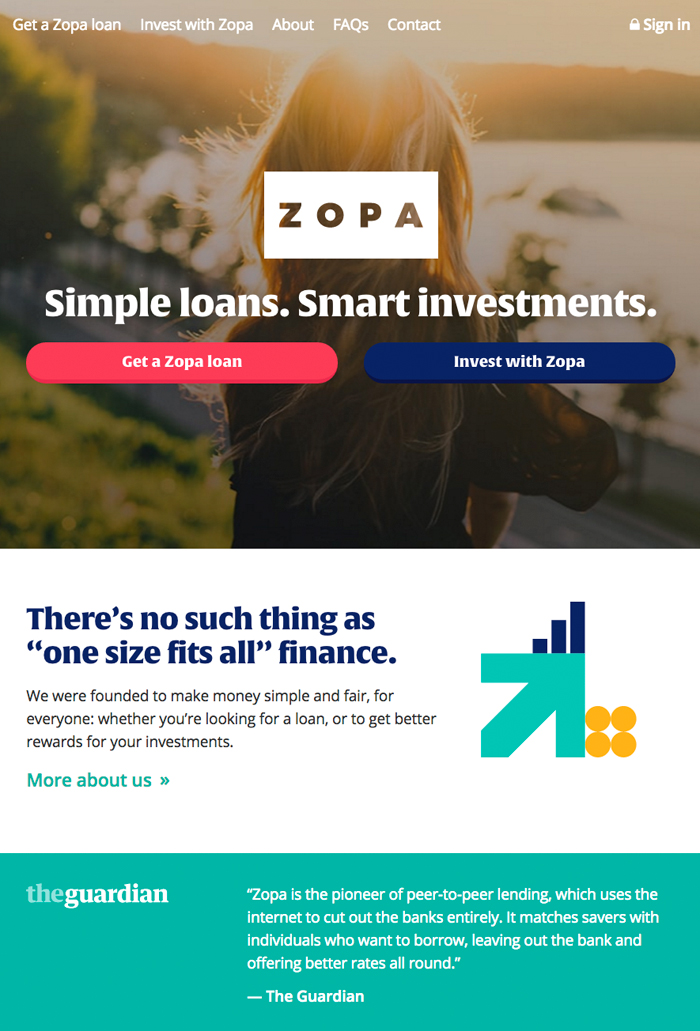
Image via Zopa
Zopa, a UK based company founded in 2004 and consisting of approximately 200 staff members, was the first peer to peer lending company, and provides clarity on what “brand refresh” entails:
Related: The Power of Disruptor Brands and Challenger Brands
Rebranding: 15 Do’s and Don’ts for Brand Success
/0 Comments/in Brand Relaunch, Brand Research, Brand Revitalisation, Brand Risk Management, Brand Strategy, Rebrand, Rebranding, Rebranding Mistakes, Revitalized Design /by Lorraine CarterSince 1903, the Pepsi-Cola (and later Pepsi) logo has seen many changes and facelifts in the form of rebranding and revitalisations. Through the last 100-plus years, the logo has evolved from what we might consider today an old-fashioned typeface through many fresh new looks.

Image via Pepsi
But while it’s interesting to follow the evolution of a well-known brand, let’s be perfectly clear. Changing a logo, altering the colour or even tweaking the name is not a rebranding strategy. Rebranding is much more than a design facelift. It may result in the design of new logos and the creation of new brand names, but it all starts as with your brand strategy first long before anything else relating to design is considered.
It’s essential to note that branding is NOT marketing or design but the bedrock foundation underpinning your whole business so getting your rebranding strategy right is critical to your success. In short, your rebranding strategy provides the direction for all your marketing, communications, positioning, language, messaging along with design.
And there are many strategic reasons to rebrand. A company may need to rebrand to:
- Re-establish its market prominence
- Acknowledge and reflect a major acquisition
- Announce a new technology or invention that changes its mission and vision
- Revitalize the voice and significance of the brand
- Refocus the company around major customer and/or industry trends
- Reflect a strategic move to reach new markets
- Give new life to flagging sales
- Move beyond a negative event
Whatever the reason, the key is to use your rebranding to help move your business and its products and services forward. Regardless of whether you’re rebranding a bank, hotel, power company or canned fruit, having the right strategy makes all the difference.
Want to discover more about rebranding to build your standout, №1 powerhouse, premium priced brand working with us so you can increase your profits and leave your competitors way behind?
- Schedule an appointment — we can meet in person or online
- Allow us to create a customised plan for you
- Let’s implement the plan together
- Contact us [email protected] or ring +353 1 8322724 (GMT Dublin/London time 9:00 – 17:30 weekdays)
One study of the hotel and hospitality industry in the United States attributes a 6.31% increase in occupancy to rebranding—and 60% of that to the power of the brand.[1] As researchers explain in their study, “Corporate Rebranding: An Integrative Review of Major Enablers and Barriers to the Rebranding Process”:
“Critical to successful corporate rebranding is the identification and application of six major enablers, including strong rebranding leadership and coordination among multiple functions and stakeholder groups.”[2]
To this end, we’ve compiled our list of 15 Do’s and Don’ts for Rebranding Success in order to help you navigate your next strategic rebranding and focus on critical leadership and coordination issues. We’ve been leading clients through all the various aspects of rebranding for more than twenty years so we want to ensure you engage in the process successfully by starting off on the right foot!
Also to help you achieve success, get our free download “Top 20 Rebranding Mistakes to Avoid.” here
We know that sometimes it’s a struggle to rebrand or revitalise your brand successfully yourselves so we’ve developed three different ways of working with us to help you rebrand successfully. So depending on your preferences:
- We can build your brand for you – find out more here or get in touch [email protected] or ring +353 1 8322724
- Empower you to build your brand – check out the Persona Brand Building Blueprint™ Mastermind here. This is a two-day intensive where you work on your brand with us codifying and mapping out your brand strategy for business growth. Alternatively, join our half-day Branding Accelerator Masterclass for a fast-injection of brand building essentials
- Want a DIY solution? Check out our ‘How to Audit Your Brand’ eprogramme here and How to Build a Brand eprogramme here
Top Rebranding Do’s and Don’ts
How important is your brand? The market research firm Millward Brown attributes more than 30% of the value of companies in the S&P 500 to the brand value.[3] Your brand is just as important, which is why you can’t cut corners during your rebranding.
1. DO challenge your reasons for rebranding
It’s not enough to “feel” that it’s time for a change. Whether you’re rebranding a product or the company, question the strategic advantage of your decision. What do you gain? Are there any other options or avenues open to you short of a complete rebrand? In other words, go into this with your wide eyes open and a clear sense of where you’re going and why.
When the Langham Hospitality Group decided to refocus its business to better serve a large middle-income population, it rebranded the business to focus on its new mission of service. In this discussion on Bloomberg, CEO Robert Warman clearly articulates their thinking:
2. DON’T focus your rebranding on simply redesigning your logos, changing colours and replacing fonts
There’s nothing wrong with giving your brand a facelift; just don’t confuse a design initiative with the objective of a true rebranding which is driven by a specific strategic intent. When you rebrand, you are communicating a fundamental change in the business.
In this video, UPS helps its SME / SMB customers understand the power of branding (and by extension rebranding). This is a strategic endeavor that extends to absolutely every aspect of your business…right down to a greeting and a handshake.
3. DO assess exactly what’s not working or what needs to change (and why) as well as what needs to remain the same by giving your brand a health check before rebranding
Just as you need to challenge your decision to rebrand (#1) you also need to dig deep into all aspects of your business to ensure you change/expand/update those things that need to be rebranded. And at the same time retain what’s still working and still reflects how you are doing business going forward.
If you need direction and support in giving your brand a health check feel free to get in touch [email protected] or give us a ring T: +353 1 8322724 (GMT hours). Alternatively, you can also give your brand a health check yourself to identify its strengths, weakness and areas for potential innovation and growth using our Auditing Analysis Accelerator™ programme. This is a step-by-step DIY walkthrough, complete with downloads, questionnaires and checklists, to help you audit your brand yourself. You can watch a section of the programme here.

Want to give your brand a health check. Use the Auditing Analysis Accelerator™ programme – get it here
Consider Malaysia Airlines. After the Flight 370 tragedy, you might think that their decision to rebrand would mean starting completely fresh—even changing the name. But as the new CEO Christoph Mueller tells CNN, there is so much loyalty to the brand that they feel that they need to keep the name.
4. DON’T use your competition as the focus of your rebranding
While it is essential that you know what your competition is doing and how you fit in among your key competitors, don’t let the competition drive your decisions. Do what is best for your business, what makes the most sense in terms of your products and services and what attracts your customers.
When you let the competition drive your business decisions, you’ll almost always end up playing a game of catch up or “me too.” To stand out, you need to be true to your vision, your culture, your philosophy and how it intersects with the values of your customers.
5. DO your homework on industry trends and your market before rebranding
While you need to know who your competition is and what they’re doing, your best insight is going to come from having a thorough up-to-date understanding of both industry trends and the wants and needs of the customers you are trying to reach.
This is doubly important if part of your rebranding strategy is to try to expand into a new industry or new marketplace. And your research should include talking with prospective customers in this new market. The more you know going into your rebranding effort, the better your position and your potential to succeed.
6. DON’T rebrand because it’s supposedly ‘cool’
Familiarity can breed boredom. And who’s more familiar with a brand than the people who deal with it every working day. Don’t fall into the trap of thinking that you need something fresh and new just because it’s been around for a while.
But here’s the good news: If you understand the strategic importance of your brand and how it stands for who, what and why you’re in business, you’ll be less apt to fall into this trap. Maybe you need to refresh your logo, change your packaging, advertising, update your brand collateral or bring something new to your social media approach. But these are more tactical changes—window dressing—and not a dramatic change in strategic direction.
7. DO involve all your employees in the rebranding discussion
When a business decision requires rebranding, it needs to be felt and carried out at all levels of the company. Everyone from the CEO to the newest hire has to be on board. But rather than hand down a new brand directive from the top, start your rebranding at the grassroots. Involve everyone in the process. Invite their input. Ensure that where management thinks it needs to take the brand is something that everyone can deliver on. Your employees will be more willing to do their part when they are empowered to participate in the process.
8. DON’T forget to interview your customers and get their perspective before rebranding
Just as you want to talk with prospective customers in any new markets you plan to reach, you don’t want to leave your current customers behind. Remember, it’s easier to retain customers than acquire new ones. So make sure that customers understand your decision to rebrand and feel comfortable that you’ll still be able to meet their wants and needs. And invite them to share their thoughts. They may have a perspective that you need to incorporate into your rebranding strategy.
9. DO work with experienced brand experts who can help guide you through the rebranding process successfully and ask the right questions along the way
There are so many moving parts to developing and executing a rebranding strategy that it pays to work with experts—people who live and breath the branding process. Not only can a branding consultant make your rebranding process easier, they can also help ensure that you don’t overlook some critical steps.
10. DON’T wait until after you change direction with your rebranding to think about the rollout
While it’s easy to get caught up in the details of the rebranding strategy itself, there are a lot of tactical steps to launching your rebranding—e.g., the event, a strategic location, how to employ social media. These are not afterthoughts. It’s not as simple as one day posting a new logo on your website, announcing an acquisition or creating the content and brand collateral needed to reach a new market.
You need your rebranding to launch without a hitch. So be sure to assign part of your marketing team to create the tactical plan that will help you relaunch your brand successfully.
11. DO manage your customers’ expectations with your rebranding
In addition to getting your existing customers’ perspectives on your brand and where you’re going in the future, you don’t want your rebrand to blindside your loyal customers.
If you have field reps, plan for them to speak with customers. Let them give their customers a head’s up as well as reassure them that their needs will be fully met going forward. If you rely on inside sales and don’t have a sales force, you might have a top executive call key customers or send out personal letters. You don’t want to lose the trust of the customers that have helped you build your business.
12. DON’T try to keep the old brand alive in any form with your rebranding
During your relaunch, you’ll announce that X is now Y. And once you’ve made the announcement, don’t try to make a slow or gradual transition. Dump the old logo, the old name, the old brand collateral…everything that represented who you WERE. Trying to phase out or use up old brochures or letterhead is confusing and actually defeats the purpose of the rebranding. The transformation must happen across all your brand touch-points consistently and congruently at the same time—not months apart! Move on with confidence, strength and clarity.
13. DO communicate your new strategy and tie it directly to the rebranding so everyone understands what you’re doing and why
Few things are more important than communication. The more people understand what you’re doing, why you’re doing it, how it will impact them and the timeline for everything you’re doing, the easier it is for them to support you and help ensure a smooth rebranding process.
After TriNet, an outsourcer of HR services acquired a large company, it quickly went through a rebranding. This brief video is a clip from a longer presentation showing how TriNet keeps its customer-facing employees informed and completely in the loop.
14. DON’T forget to register any new trademarks as part of your rebranding
Whether you’re changing the name of the company or adding new branded products, sub-brands or services, you’ll naturally check to make sure the names are available. Don’t forget to register and protect these names for your exclusive use in every country or market where you plan to do business. Without registering your brand names (and the relevant brand assets like your logo artwork) you may find yourself in a losing battle later to protect the brands you’ve worked hard to develop.
15. DO discuss the ownership of any copyrights on creative outputs as part of your rebranding
Finally, there’s the matter of creative ownership. When you hire a freelance artist or graphic designer or design agency you want to make sure that you have exclusive use of the intellectual property. While the law differs slightly from country to country, you’ll probably want to establish a “work for hire” arrangement. Talk with your attorney and your brand consultant on how best to proceed. Even if you don’t end up owning the creative outright, you can pay to lock up its exclusive use.
Rebranding Case Study #1: Putting Some New Kick in Old Spice
Although Old Spice has been creating personal grooming products for more than 70 years, the brand began to stagnate in the 1980s and didn’t improve even after Procter & Gamble bought the company. That changed, however, in 2010 with an extension to the product line and the funky rebranding in the guise of the Old Spice Guy. P&G didn’t simply reposition the product; it sold women on the idea of buying its new line of body washes for their men.
Old Spice is an often-told story of a great brand comeback through rebranding. Best of all, they didn’t make the mistake of losing the trust and following of loyal customers. If there’s one weakness in the Old Spice strategy, however, it may be that they’ve failed to stay one step ahead of other brands that have followed in their footsteps with equally off-beat videos.
Takeaway: With rebranding, you can bring new audiences to an old, established brand. But once you get the momentum going (or have the good fortune of going viral) you need to keep it going with marketing automation and strong data management techniques that allow you to interact with customers.
Rebranding Case Study #2: ABM Does More Than Windows!
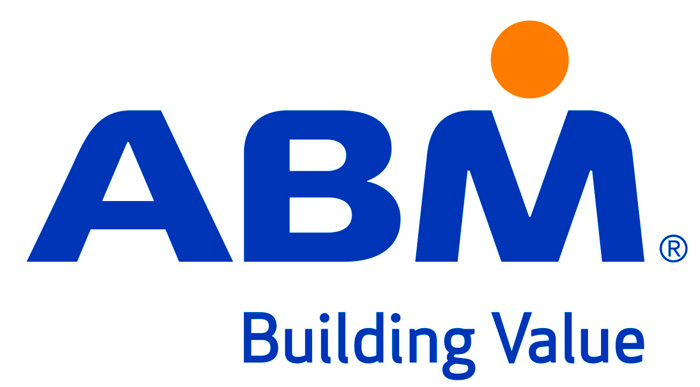
Image via ABM
Just three years after the 1906 earthquake, San Francisco was rebuilt and booming—enough so that Morris Rosenberg started up his window-washing business. In 1913, Rosenberg renamed his one-man operation American Building Maintenance Company and expanded into comprehensive janitorial services. Today the 100,000 employees of ABM Industries provide janitorial and facilities management around the world.
But ABM had a problem. While the company’s capabilities had expanded dramatically, most prospective customers still thought of it as a successful custodial service. ABM needed to build awareness for its expanded capabilities, including security and property systems engineering. It used the 2010 acquisition of the Linc Group to gain that awareness through a strategic rebranding that;
- Reorganized and simplified the range of service offerings
- Focused on the overall value ABM delivers through its integrated facility solutions
- Included a whole new brand identity
Takeaway: Rebranding your company can help you get the attention you need when you have a big message to deliver. In the case of ABM Industries, they capped off the whole process—new logo, reorganization of services, a new tagline—by ringing the NYSE closing bell in October 2012. ABM sent a message throughout the industry that this company is still growing and looking to the future.
Are You Ready for Rebranding?
If you think your company will benefit from a rebranding, ask yourself:
- Do we have a good reason for rebranding? If so, you need to be able to articulate it clearly.
- What are the strategic implications for our business? Is there any potential downside? Will this move leave any of our stakeholders behind?
- Have you presented the task to the entire company—from CEO to newest hire?
- Have you looked at your brand through your customers’ eyes and talked with them about your decision?
- Have you considered how you will bring your business plan into alignment with your brand going forward?
- Do you have a thorough plan for rolling out and implementing your rebranding? Do your employees understand the plan, know how it impacts them and have confidence they can live up to the objectives?
We know that sometimes it’s a struggle to rebrand or revitalise your brand successfully yourselves so we’ve developed three different ways of working with us to help you rebrand successfully. So depending on your preferences:
- We can build your brand for you – find out more here or get in touch [email protected] or ring +353 1 8322724
- Empower you to build your brand – check out the Persona Brand Building Blueprint™ Mastermind here. This is a two-day intensive where you work on your brand with us codifying and mapping out your brand strategy for business growth. Alternatively, join our half-day Branding Accelerator Masterclass for a fast-injection of brand building essentials
- Want a DIY solution? Check out our ‘How to Audit Your Brand’ eprogramme here and How to Build a Brand eprogramme here
Want to discover more about rebranding to build your standout, №1 powerhouse, premium priced brand working with us so you can increase your profits and leave your competitors way behind?
- Schedule an appointment — we can meet in person or online
- Allow us to create a customised plan for you
- Let’s implement the plan together
- Contact us [email protected] or ring +353 1 8322724 (GMT Dublin/London time 9:00 – 17:30 weekdays)
Your Client Satisfaction Guarantee
- When you work with us we’ll create a customised brand building plan and strategy with clear investment for you tailored to your specific requirements and preferences
- You’ll know each step of your brand building journey before we start because we’ll discuss it, document it and agree on it with you before work commences
- You’ll have timelines, key milestones and deliverables to evaluate and approve for each stage and part of your brand building process
- Because we know the unexpected sometimes happens we can make adjustments along the way if you need it and if something extra is requested we’ll ensure you’re fully appraised about what that entails before committing
- As we achieve pre-agreed objectives you’ll be able to evaluate your brand building work and strategy in progress, coupled with the outcomes to ensure return on investment
Get in touch today because we’d love to get started helping you build your standout, powerhouse brand so you can increase your profits and leave your competitors way behind. Email us [email protected] or ring us +35318322724 (GMT 9:00-17:30) and ask about our VIP Brand Strategy Discovery.

Image via Zillon Designs
[1] http://journals.ama.org/doi/abs/10.1509/jmr.13.0221?code=amma-site
[2] http://onlinelibrary.wiley.com/doi/10.1111/ijmr.12020/abstract
[3] http://www.economist.com/news/business/21614150-brands-are-most-valuable-assets-many-companies-possess-no-one-agrees-how-much-they
Brand Audits – How to Use One to Grow Your Profits
/0 Comments/in Brand Audit, Brand Auditing, Brand Audits, Brand Health Check, Brand Recall, Brand Relevance, Brand Revitalisation, Rebrand, Rebranding /by Lorraine CarterPerhaps you’ve seen some of the headlines. This one from Bloomberg pretty well sums up the lot: “Snoopy, Loved as Friend, Lacking as Leader, Gets Boot at MetLife.”[1]
Yes, after a 30-year run, MetLife is dropping Snoopy and the Peanuts gang. If you’re wondering why a company would break up a winning partnership and transform a brand that has worked for three decades, you’ve come to the right place.
While the decision to drop the iconic dog and his cartoon friends may seem capricious, you’ll see that, in fact, this is the case of a company that understands the critical connection between its brand and its business decisions. Markets change, new trends emerge, disruptive competitors alter long-standing rules and customer preferences evolve — all of which impacts your brand and consequently your business strategy.
Regardless of their size, companies that are trying to stay relevant, keep growing, expand their customer base, maintain high recognition and recall and convert awareness into greater familiarity are constantly wrestling with questions about their brands. And the most effective way to answer those critical questions is through a brand audit; see one of our previous posts entitled “Brand Audits: Why You Need Them and How to Perform One.”
Why is this important? Consider the findings in the 11th annual Accenture Global Pulse Survey: Once you lose a customer, 68% will not come back.[2] If better brand management can help retain more of those customers, then you need to invest the time, the thought and the effort into ensuring that your brand is delivering. And a brand audit is one of the most effective tools to measure and evaluate your brand performance.
“There is only one boss. The customer. And he can fire everybody in the company from the chairman on down, simply by spending his money somewhere else.”
Sam Walton
What’s in a Brand, and Why Brand Audits are Key to Growing Profits
If you want to evaluate your brand in terms of its capacity to deliver profits or return on investment (ROI), it pays to be ruthless in your analysis. In other words, take a page out of Forbes and its technique for assessing the value of a brand.[3] When compiling its annual list of Most Valuable Brands, the magazine’s analysts focus on the numbers — not “fuzzy consumer surveys” — and the ability of the top brands to generate revenue.
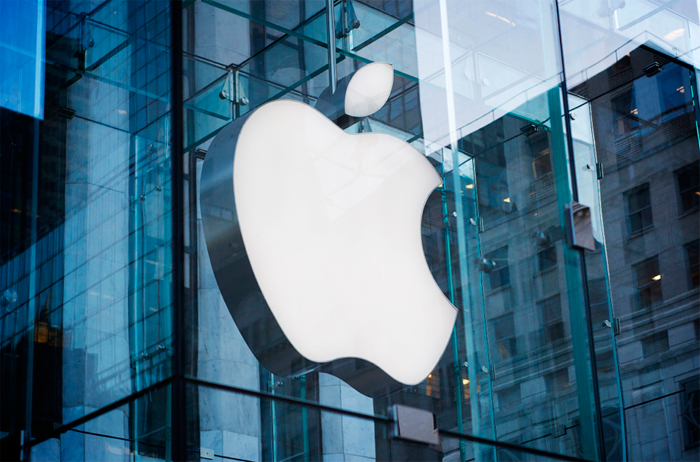
Image via livesicilia.it
In 2016, Apple again takes the Number 1 spot with Forbes estimating the brand’s value at $154.1 billion — definitely a brand worth polishing. If your brand is worth even a fraction of that, you can see why your brand deserves more diligent attention. And even if it’s not there yet, you can appreciate the potential, which makes a brand audit an invaluable tool for brand growth. Any asset with this much value (or potential value) is worth caring for with a regular health check.
And Speaking of Brand Value…
The findings of The Chartered Institute of Marketing’s survey indicate that 75% of marketers consider their brand value and positioning when making any major business decisions. However, respondents also acknowledged weak follow-through and a lower brand experience for customers when management, employees and customers fail to understand and/or appreciate the brand’s role in the business.
Takeaway: A brand audit is not a fluffy light weight marketing exercise. It’s a strategic tool capable of giving you valuable insight into aligning your branding with your business decisions, and needs to be understood by management and employees alike.

Image via The Chartered Institute of Marketing exchange.cim.co.uk
Case Study: MetLife. Navigating Life Together
This video from the Wall Street Journal captures clips from MetLife’s long association with Snoopy. But in its October 20, 2016 press release, MetLife global CMO Esther Lee explained the decision to move away from Snoopy and the Peanuts gang: “We brought in Snoopy over 30 years ago to make our company more friendly and approachable during a time when insurance companies were seen as cold and distant…as we focus on our future, it’s important that we associate our brand directly with the work we do and the partnership we have with our customers.”[4]
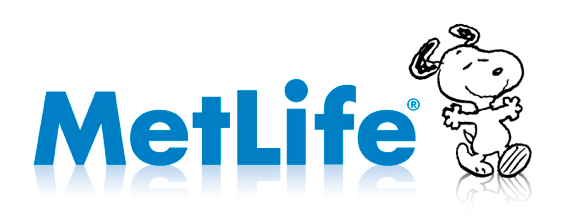
Image via MetLife
Today, MetLife is in the middle of a significant corporate realignment. It’s spinning off its domestic retail life insurance business in the United States to focus more on group life insurance sales and international business operations. Consequently the old logo must give way to a more corporate and international style reflective of its changed positioning:

Image via MetLife
But a rebranding of this magnitude, the decision to drop the cartoon characters, create a new logo, and change the tagline are only part of the process. It’s the result of a thorough analysis and understanding of the brand —in terms of the company, its competition and its customers and prospects.
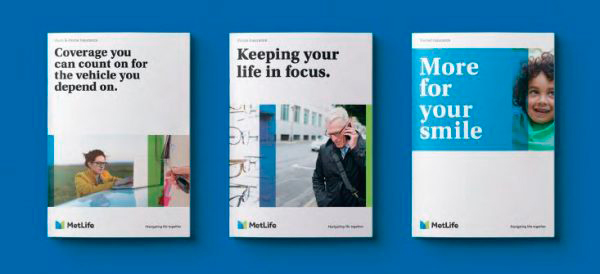
Image via MetLife
You face many important tasks as you begin a rebranding process — potential pitfalls and mistakes as well. To help you prepare, download our free report, “Top 20 Rebranding Mistakes to Avoid.” Sign up with your name and email address, and we’ll send you a copy.
Are You In Need of a Brand Audit?
A total rebrand or brand refresh is only one reason to consider a brand audit as a place to start when determining if your brand is performing. Listed below are key business reasons for conducting a brand health check…and why your brand may not be delivering significant profits:
- Losing market share to your competition in your industry or product segment
- Your business or organizational focus has changed
- Poor performance in online search, no longer landing on page one with Google or insufficient impact in digital media
- Numerous business changes coupled with endeavours along the way to adjust your brand may have undermined your brand identity and created confusion both in your customers’ minds and amongst your internal team and stakeholders alike
- Your sales are declining and your marketing strategy is not delivering the required results
- When questioned about your brand, customers and prospects seem to have little or no brand recognition and low brand recall
Brand Audits Help You Grow Profits
When you conduct a brand audit effectively, driven by clear objectives, you can:
- Pump fresh interest into your brand
- Present a more consistent (and stronger) identity aligned more closely with the goals of the business
- Evaluate your strengths and weaknesses so you can identify what to build on and what to work on, or eliminate and where to improve performance
- Gain a greater understanding of your customers — what they like, what they need and what they want from you and what they don’t like — and how your business and your brand can better meet their needs
- Take advantage of the brand audit process to build greater communication internally across the company (with employees and partners) and externally (with customers, prospects, general public and target markets)
For additional resources and tips, check out our article “Brand Audits: 10 Things Successful Brand Owners and Managers Must Know.”
Start Your Brand Audit with Well-Articulated Objectives
Start your brand audit with a thorough understanding of what you want to accomplish. What are your objectives? Are you trying to determine why your market share is dropping? Do you need greater insight into how to reposition your company going forward? Are you trying to build a recent acquisition or change in direction into your brand image and messaging? Do you need to convert customer or prospect awareness into stronger brand familiarity? Do you need to measure sentiment for your brand in the marketplace?
Even if your brand is performing reasonably well, avoid complacency at all costs — now is the time to give it a health check to prevent any downward turn so you can leverage it more strongly to accelerate your profit growth.
While you’re thinking about these and other questions, take a look at our step-by-step brand audit ecourse. If you want to give your brand a health check yourself, our Auditing Analysis Accelerator™ programme can help you with an under-performing brand, a routine brand health check or a comprehensive analysis to identify your strengths, weaknesses and growth opportunities.
By keeping your focus squarely on your objective(s) you’ll end up with a report, a set of recommendations and a blueprint for going forward that is an actionable document that will help you make the right decisions. You’ll come away with a strategy and a starting point for developing the necessary marketing tactics.
Elements of Your Brand Audit Methodology
There are many ways to audit your brand, and not all audits will require every possible type of analysis. In fact no two brand audits are exactly the same. The depth and scale of a brand audit is dependent on your objectives, resources and timelines. Your questions will help you determine your choice of methodologies and the metrics.
Takeaway: There is no right or wrong brand audit…only the one that gets you the information and answers you need to make the right decisions going forward so you can accelerate your growth.
Here Are 6 Keys Steps and Questions to Get You Started With Your Brand Audit:
Step 1: How does your brand align with your target market?
With your basic questions in hand, you can begin the research phase of your brand audit.[5] You’ll need to collect a lot of background information: Google and Bing searches are a good place to start. You can also hire a professional to conduct an in-depth analysis of your industry. And in addition to visiting your competitors’ websites and social sites, you can collect competitive intelligence through resources such as Hoovers, Dun & Bradstreet, SimilarWeb and Alexa. Some of the topics you’ll want to research:
- Market Intelligence: Market niche, target audience
- Company Information: Mission, vision and Unique Selling Proposition (USP), sales trends, customer support results, logos and brand image documents, brand collateral material
- Industry Insight: Industry trends, competition (who are they and how do they compare in terms of price, support, customer experience, product offerings?)
Step 2: Does your brand deliver on your business objectives? Market intelligence? And industry insight?
With the raw data in hand, you need to assess your brand image, message and actions in the context of your company, your products, your market and the industry. How effective is your brand? Is a weak brand resulting in business being left on the table? Are you losing to stronger, more recognized brands? Do your employees, customers and prospects align with your brand? Can they articulate what your brand stands for and what makes it different to your competitors?
- Discuss the your brand internally with management and employees
- Query customers and prospects with online polls, phone surveys and email questionnaires
Case Study: The IKEA Brand Starts With Its Customers’ Needs
The IKEA Group reminds us that both good business ideas and good branding starts with a thorough understanding of customers and their needs. In “The Story of How We Work,” IKEA has turned the story of how they deliver the right products at the right prices with the right corporate culture into the brand.
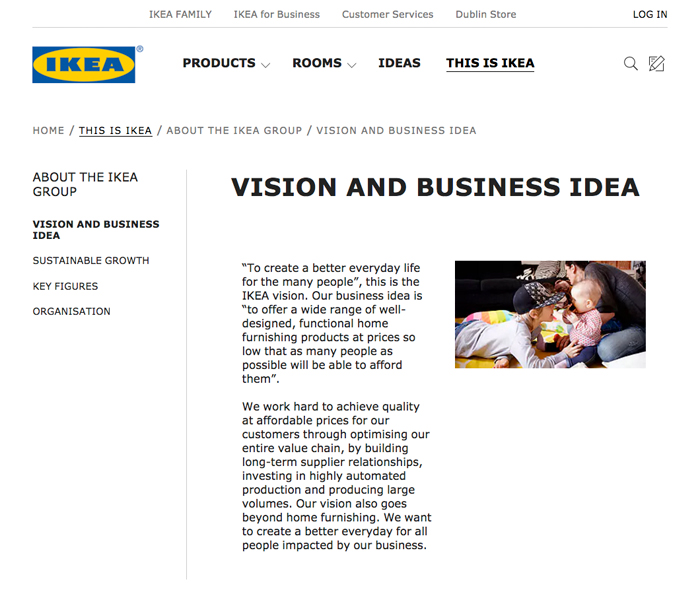 Image via IKEA
Image via IKEA
Takeaway: Using digital illustration to sketch the business process reinforces the how-to and DIY aspects of the IKEA brand. The fact that the story comes full circle—back to the customer—proves that people and their needs are always central to the business and the brand.
Step 3: What’s your SWOT?
Conduct a SWOT-type analysis of your brand to identify and list your brand’s strengths, weaknesses, opportunities and threats.
- What are the best assets associated with your brand — e.g. visual, message, trust? These are strengths you can leverage
- What are your weaknesses and liabilities — e.g. negative press, limited recognition, small audience? Not only do you need to know about any downsides you need to decide if liabilities can be turned around or offset
- Where are your opportunities — e.g. new or untapped audiences, new products well positioned in the market, potential market disruptors? Once identified you can consider the strategy and tactics that will enable you to take maximum advantage of opportunities
- Where are the threats — e.g. new competitors, changing market trends, next-generation technology, challenger brands? Once you know the threats, you can develop ways to mitigate their impact
Case Study: Burberry Leverages its Origins
When Angela Ahrendts joined Burberry in 2006 as its new CEO, she and then Chief Creative Officer Christopher Bailey focused on new and innovative ways to leverage their strength. Burberry asked, “What do we have that they [the competition] don’t?”
 Image via Burberry
Image via Burberry
Takeaway: Burberry went back to its strong roots: British origins and the iconic trench coat. With this insight, the implementation was simply a matter of using creativity in presentation, social media, music and models to build a brand that worked in the 21st century.
Step 4: What’s the brand recognition and recall factor for your visual elements, your messaging and your actions?
Questionnaires, polls and one-on-one conversations will help you understand how effectively your brand is connecting with customers and prospective customers. This is a somewhat subjective process — since you’re relying on people to tell you honestly what they think. It will, however, help you understand the associations and awareness surrounding your brand. Ask customers and prospects about all aspects of your brand, including:
- Logo, colours, taglines
- Brand collateral materials
- Product packaging, trademarked programmes and services
- Customer support programmes
- Consistency of brand across products, websites, marketing materials social sites, etc.
Step 5: Is your social presence aligned with your mission, vision and business objectives?
Given the strong digital presence of most marketing today, you may want to do a social media audit to determine if your brand comes through loud and clear and consistently and congruently on all your social platforms. For example:
- Do you have a consistent brand image and congruent messaging across all your social sites?
- Is your website’s user experience consistent with the brand experience you want for customers and prospects?
- Are you taking full advantage of the features and strengths of each social platform to best position your brand while maintaining consistency?
Step 6: What’s your traffic analysis?
You’ve asked customers and prospects for their opinions about your brand. By measuring online behaviour you can separate what people say from what they actually do and how they respond to your digital brand marketing?
- Are the number of visits to your website, social sites, digital ads increasing?
- How many unique views do you have each month?
- How many are return visits?
- Are your Likes growing along with sales?
- What’s your bounce rate? Are people spending more time on your sites? Are they downloading lead generating brand collateral?
- How many conversions do you have? Are people clicking through, responding to your call to action and/or buying?
An Inspiration and Reminder to Think Different
In 1997, Steve Jobs had just returned to Apple, and one of his first tasks was to rescue the brand. After several years of confusion and poor management, Apple products and the brand itself had declined and the company faced the possibility of failure.
In this video, Steve Jobs explains his plan to revive the business and the brand by focusing not on speeds and feeds (features) but the value of human innovation and positioning Apple as the company that understood, respected and supported those among us who Think Different.
Jobs’ explanation, serves as our reminder to focus our brand audits on our strengths and our customers. We increase our chances of succeeding when our brand audits bring us in touch with our strengths and our customers’ needs and help us put both in the context of our industry, our target markets and business objectives. Writing in Forbes in 2013, Columbia University professor Panos Mourdoukoutas explained brand value: “Those attributes must ‘seduce’ the consumer’s mind, address genuine consumer anxieties and emotions — and be innovative.”[6]
Five Tips for Using Your Next Brand Audit Health Check to Increase Your Profits and Grow Your Business
- Business decisions and brand go hand-in-hand. Tie any significant changes in the business (e.g., acquisitions, future plans, product restructuring) to the brand. A brand audit will help you understand where you stand today and what it will take for the brand to engage customers going forward.
- Focus on context. Your greatest opportunities lie at the point of convergence across company values, customer desire and the state of the market.
- Leverage your strengths. Start from your core values — the attributes that built your business. Then determine how you can carry them forward. Whether it’s a matter of getting back to basics or pumping new life into trusted values, don’t loose what you’ve spent years building. Reassure customers that you are who you’ve always been and will continue to be.
- Reach out to customers. You can’t make business decisions and establish your brand identity in a vacuum. Talk with customers, social and website visitors and, in some cases, random members of the public. Invite them to take part in surveys, phone interviews, focus groups and one-on-one interviews.
- Don’t overlook your digital branding. Today your brand extends to everything you do online — websites, social sites, digital ads, YouTube videos and more. Plus, with new tools and marketing automation technology, you can quantify more of your results. You can see what people are doing and compare results with what they tell you.
[1] http://www.bloomberg.com/news/articles/2016-10-20/metlife-to-phase-out-snoopy-branding-as-ceo-reshapes-insurer
[2] https://www.accenture.com/us-en/insight-digital-disconnect-customer-engagement
[3] http://www.forbes.com/sites/kurtbadenhausen/2016/05/11/the-worlds-most-valuable-brands-2016-behind-the-numbers/#126ce3897383
[4] https://www.metlife.com/about-us/brand/MetLife_Launches_New_Brand-Press_Release.pdf
[5] http://www.inc.com/guides/201105/10-tips-on-how-to-research-your-competition.html
[6] http://www.forbes.com/sites/panosmourdoukoutas/2013/10/05/apples-most-important-branding-lesson-for-marketers/#46c5410e18e2
Digital Brand Identity Essentials – How to Build, Resonate and Grow
/0 Comments/in Brand Audit, Brand Auditing, Brand Audits, Brand Identity Design, Brand Revitalisation, Digital Brand Identity, Rebrand, Rebranding, Revitalized Design /by Lorraine CarterSuccessful branding requires consistent communications both on and offline. The question is, is your digital brand identity consistent and congruent with what your brand stands for? Does your brand strategy fully integrate your digital brand identity? Does it congruently express what you stand for? Is it well thought out and compelling? Does your digital brand identity connect with your customers, serve them and give them great value? Do your customers even care?
As you build your winning brand on its fundamental pillars, you fill its heart with the essential values of your organization, be that a product or service. You craft your brand promise to let people know what your brand will deliver. To make that commitment heard, it’s mandatory that your brand is active and fully engaged wherever your customers (and potential new customers) are. Increasingly, that’s digital and especially via mobile.
Google Goes Mobile-First
Google got everyone’s attention in April 2015 with an update that put mobile-first indexing on every marketer’s lips.[1] In today’s “always connected” marketplace, small businesses (including those with a bricks and mortar presence) must think digital…more specifically, mobile first, desktop second.
Years ago, marketplace presence might have meant a choice corner shop location in a vibrant neighbourhood, busy shopping mall or flashy billboard advertising supplemented by a basic website.
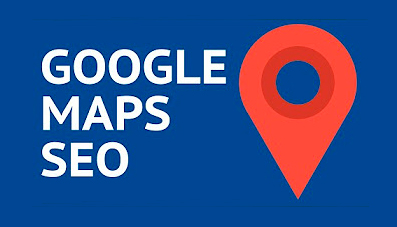
These days, “A successful website has gone from a ‘nice-to-have’ to an absolute necessity for almost all businesses,” counsels the UK’s National Federation of Self Employed & Small Businesses Limited.[2]
Your digital brand — and what others think about it — is in your customer’s pocket on a 24/7 basis.
Always-On Brands Mean the Future is Now
People just love their mobile devices. Your customers don’t leave the house without their smartphones. In fact, research[3] shows that one-third of Americans check their phones before brushing teeth in the morning.

Image via GigaOm.com
Approximately three-quarters of mobile phone owners sleep with — or next to — their mobile phones (71%).
- Younger Millennials (ages 18-24) are most likely to sleep with their smartphone on the bed (34%).
- In the morning, more than one-third reach for their mobile first thing (35%), before coffee (17%), or a partner (10%).
- A majority (89%) check their phone several times a day (89%), or constantly (36%).
- Nearly half (44%) of Americans say they couldn’t make it a day without their mobile device.
- About one in 10 (11%) respondents say they would last less than an hour. Of those, more than half (52%) check their smartphone at least every 5 to 10 minutes.
Brands Must Avoid Band-Aid Solutions if They Want to Build a Winning Digital Brand Identity
A band-aid solution is nothing more than a quick fix for a systemic problem that’s bound to re-emerge later. If your mobile communications strategy is lagging, there’s a good chance that your brand needs a refresh or a rebranding.
Best practice says that if you’re not reaching mobile customers, it’s time to start…yesterday. It’s no longer a question of which brands gain increased market share by attracting customers via the internet. It’s now a basic question of brand survival.
Writing in the Harvard Business Review, digital consultant and investor Barry Libert says, “Transforming an organization is difficult, and the research proves it. But it is still worth doing. Forrester’s assessment is that by 2020 every business will become either predator or prey. As a leader, you likely already know the basics of managing change, but a digital transformation goes deeper…”[4]
There’s little point for a small business to invest in online presence without taking a deeper dive into the life and the long-term health of your brand. Perhaps that’s where the expression “like brand new” comes from?
If you need to evaluate your brand’s weak points, areas in need of innovation and change and opportunities for growth then now is the time to use the Auditing Analysis Accelerator™ for your brand. It’s an online programme that takes you through, step-by-step, the process of giving your brand a health check. In fact the Auditing Analysis Accelerator™ is a critical brand evaluation process that’s an essential part of every brand owner’s or manager’s toolkit.
How to Know When a Brand Refresh is Required
Consumers and businesses alike are aware that brands age, just like everything does.
- Has your brand seen a drop in sales?
- Is your brand losing market share?
- Has competition for your brand heated up?
- Does your brand message lack oomph?
- Is your brand logo and supporting brand collateral outdated?
- Does your brand still reflect your customers’ preferences?
- Have you got a great new service or product?
- Are you looking to expand your brand’s customer base?
- Has your brand had a merger or created a partnership?
At Persona Design, we share the top reasons why SMEs may need to refresh, revitalize their brand or a complete rebrand and how to achieve successful outcomes for both processes.
The good news is that you don’t necessarily need to start from scratch. But, let’s be perfectly clear about what a brand refresh is not. A brand refresh is not just a new colour for your logo, a tweaked tagline to accompany it and an updated website! A brand refresh is a strategic re-think that provides the key to a company’s long-term survival and market leadership.
The bad news is that procrastination will only make the problem worse.
Why a Brand Audit is the Way Forward for SME Businesses
Large corporate brands are constantly refreshing coupled with developing and launching new services to market. We’ve all seen the parade of boxes on the grocer’s shelf declaring “new, improved.” Car manufacturers produce new models every season to sustain the ever hungry consumer appetite for ‘new’.
Interest builds as Pantone® unveils a new colour of the year to reflect the latest colour trends — also enabling colour aficionados to leverage colour psychology to the full to further increase sales.
As an SME / SMB or smaller business, the timing for a brand refresh is actually a larger undertaking because it isn’t such a frequent occurrence. The first question is: Do you need a refresh or a rebrand, and where to begin? The quick answer is: Don’t guess.
Rebranding strategy is a complex process that allows no wiggle room for getting it wrong. Happily, a brand audit provides a tried and tested tool to nicely remove the urge for any guesswork.
Fine-tune your brand’s identity. A professional brand audit will identify weaknesses and shine a light on opportunities, identifying new areas to grow your brand and potential new customer audiences. These steps are critical before investing in a rebrand, refresh, new website presence or any other brand collateral for that matter.
If your brand message isn’t responsive and on point, there’s no point in an astonishingly beautiful mobile app or web site. If you’re struggling with your brand message to make it standout and be trusted, loved and referred by your preferred customer then the Personality Profile Performer™ is the online brand building programme you need right now.
What a Branding Agency Can Do For Small Brands
It’s enlightening to study big budget, big brand name examples of successful updates that have harnessed the power of the internet. Great case studies emerge:
- The swagger of Old Spice on YouTube (53 million views)
- The cultivation of Harley-Davidson fans
- The story about rebirth of heritage brands like Converse
However, SME brands can achieve big successes with rebranding to include digital presence. Here are several examples:
- A restaurant called Mama’s Pancakes serving only breakfast has added lunch and dinner. A rebrand draws attention to the new hours, midday and dinner menus coupled with a proactive digital brand strategy developed for Instagram and Facebook.
- An accountant’s firm named A Hand for Small Business who focused on business accounting has added individual tax return preparation. A rebrand ensures that her brand speaks to both types of customers. Her digital strategy ensures expert posts on LinkedIn support her repositioning brand strategy, raise her profile and highlight her specialist services.
- A primary school that expands its class offerings, age groups, or single sex status must rebrand and develop a strategy to reach parents of infants and toddlers. Facebook for Business is one way to target custom audiences by demographics and geography.
- A barbershop called Billy’s Beard changes its focus from men’s grooming to a unisex salon needs to rebrand both in-store and online. The owners embrace a presence on Pinterest and Instagram to supplement their mobile responsive website.
- A long-term serviced apartment complex called Urban Homes that now markets to short stays needs to rebrand to compete with hotels and private home rentals such as Airbnb. A completely revamped online presence is required.
Are you an SME / SMB business owner?
Think about these six questions to ask yourself about the state of your brand’s health:
- How can I identify new growth opportunities?
- Am I completely happy with my current market share?
- Is my brand promise resonating with my customer base?
- Does new business walk in every day? If so, do I know what prompts it?
- Am I completely happy with my brand packaging? My brand’s online presence?
- Do I have a 1-year, 3-year, and 5-year business plan in place?
[1] https://support.google.com/adsense/answer/6196932?hl=en
[2] http://www.fsb.org.uk/first-voice/fifty-great-tips-to-building-a-winning-website
[3] http://newsroom.bankofamerica.com/files/doc_library/additional/2015_BAC_Trends_in_Consumer_Mobility_Report.pdf
[4] https://hbr.org/2016/07/7-questions-to-ask-before-your-next-digital-transformation
Brand Crisis – How to Manage, Survive and Thrive
/0 Comments/in Brand Audit, Brand Auditing, Brand Audits, Brand Crisis, Brand Failures, Brand Health Check, Brand Relaunch, Brand Reputation, Brand Revitalisation, Brand Risk Management, Brand Risk Mitigation, Brand Strategy, Brand Values, Branding, Customer Engagement, Entrepreneur, Rebranding, Situation Analysis /by Lorraine CarterThe one thing every brand product or service can count on is that there is a brand crisis in your future. No brand is immune. And, because bad news travels fast (faster than ever, due to social media), time is of the essence.
When do you have a brand crisis on your hands? Whenever there are “unexpected events that threaten a brand’s perceived ability to deliver expected benefits, thereby weakening brand equity.” [1]
It’s a Brand Crisis: First Things First
Step 1: Damage Control
Whether Mother Nature or manmade forces are at work, it’s critical that no matter how robust a brand you have built, you do have a “just-in-case” plan on the Public Relations shelf. A crisis management professional will guide you on the immediate essential steps and basic principles[2] of crisis management, and importantly, on your specific scenario.
From the very first moment that a sudden event, a mistake, or a piece of news impacts a brand negatively, savvy brand managers need to know:
- what to do first
- what never to say to the media
- how to prioritize
- what social media tactics are best
Step 2: Assessing the Brand Damage
According to the Financial Times, “When a brand crisis breaks out, consumers and other stakeholders (e.g., shareholders, the media, regulators) are likely to raise questions about the affected brand and why the crisis happened such as: who is to blame? Is the event likely to happen again? Is it true? What does the crisis signal about the brand?”[3]
When the frenzy begins to abate, your brand requires large amounts of tender loving care. The central question to be answered relates to the prognosis and timing for recovery. That is, brand owners and managers need to analyze both the short-term and long-term effects of the damage caused by the crisis for complete, cool-headed consideration.
Step 3: Short-Term Brand Damage
Assuming no loss of life or property, your short-term considerations are typically:
- sales
- consumer confidence
- an attack mounted by opportunist challenger brand(s).
Therefore, the task is to recover revenue, earn consumers’ trust, and deal with competitors in the right way.
A silver lining comes from gaining positive lessons learned from a negative experience…it’s never more important than when one’s “dirty laundry” has been on display for all to observe.
Nevertheless, a brand audit followed by a refresh or re-branding may very well be in order at this critical moment.
After the Brand Crisis: Getting Back to Normal
Step 4: Long-Term Brand Damage
A crisis is a harsh teacher and requires cool heads to respond rationally to an irrational situation. Ultimately, every crisis has a resolution.
How a brand deals with a crisis during the short-term damage control step will have a lasting effect on its reputation in the long-term, where it matters most. Indeed, that behaviour becomes a benchmark for the brand as conversations in the public sphere revolve around the brand’s handling of the event.
Because every situation is different, it’s impossible to say how long after the initial crisis occurs that step 4 will begin. It could be days, weeks, or months. Experts agree, “The scale and duration of this impact depends on a number of factors, including a brand’s track record and established consumer goodwill, as well as how quickly brand custodians respond to the crisis.” [4]
If you need to evaluate your brand’s vulnerabilities, weak points and areas in need of change then now is the time to use the Auditing Analysis Accelerator™. It’s an online programme that walks you through, step-by-step, the process of giving your brand an audit. A critical management tool in every brand owners arsenal.
Step 5: The Problem Gets Fixed
In a widely shared 2005 op-ed published by the Wall Street Journal[5] following the devastating Hurricane Katrina, the former chairman of General Electric presented his thought leadership memo about the five stages of a crisis. According to Jack Welch, the fifth and final stage in crisis management is when the problem gets fixed.
A benefit derived from a crisis is that it lets us know where things are broken and can help us to identify solutions so that future similar crises may be avoided. But this benefit applies only if we take the appropriate steps to learn those lessons and to apply that wisdom to our brand.

It’s mandatory to undertake the post-crisis approach strategically. In the words of Jawaharlal Nehru, statesman of India, “Every little thing counts in a crisis.”
What Now For My Brand?
As a branding expert, Persona Design can provide insights and advice about getting your brand back to ship-shape by determining:
- Whether the original brand strategy needs adjustment
- How to create a new brand promise
- To what extent the brand can recover
- Whether a brand refresh is appropriate
- Does the brand need repositioning?
- Whether a re-branding is required
- What a re-branding should look like
This process begins with a detailed brand audit focused on recovery. This procedure determines your brand’s market position versus competitors, identifies where brand strengths and weaknesses lie, reveals inconsistencies and opportunities for improvement, and flags new developments.
Option 1: A Brand Refresh
In the wake of a crisis, a refreshed brand must create and clearly communicate new company values.
Option 2: A Re-branding
A brand audit will determine whether the brand can survive. Some brands, including large ones like Arthur Andersen (now Accenture), cannot survive a deep crisis.
Calculated and deliberate brand re-building to repair brand reputation is not a frivolous process. It requires a serious and thoughtful strategy based on customer perception, behaviour and values.
Let’s look at five types of crises that commonly occur in a small-to-mid-sized company and use illustrations found within larger corporations. Note that the strength of a brand image will mitigate damage in crisis aftermath, with smaller brands being more vulnerable than these household names.
A Bump in the Road for Brands
1. Product Failures
As a small-to-medium retailer, you can be caught up in a failed product originating with one of your suppliers. It’s a costly headache for retail management having to refund customers’ money, give them replacements, deal with the supplier, while hoping the problem doesn’t get any worse or rub off on your own brand. When a product failure occurs, you may benefit from professional brand reputation management.
Example: Due to six fatal incidents, millions of unstable dresser units have been recalled by IKEA[6], which is responsible for their own supply chain as manufacturer and reseller. This product recall is one of 17 for IKEA in 2015 through mid-2016.[7]

IKEA Malm dressers (IKEA Corporate News website)
Result: Surveys indicates that the world’s largest furniture retailer’s reputation is hit hard, but the brand will survive, according to experts like Stephan Shakespeare, founder and CEO of YouGov, who writes in July 2016, “The good news is that IKEA’s overall Value Score remains relatively untroubled – in the UK at least. While this remains the case, IKEA can be assured its offering will continue to be popular…IKEA should be thankful that it has such a strong brand image, and indeed one that people around the world have a connection and loyalty to.”[8]
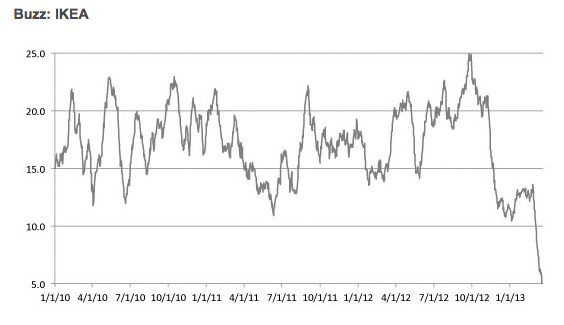
Image via Buzz Score (YouGov)
2. Brand Embarrassment
Keep your clearly defined brand values front and centre in the mind of the customer. If something embarrassing does occur, seek advice from a professional branding agency to prevent customers from expressing dismay with their feet and their wallets.
“People buy a brand because it says something about who they are and what they believe in,” according to Deborah MacInnis, PhD, a professor of marketing at the University of Southern California Marshall School of Business. “If there’s a brand that does something bad, people feel betrayed but also feel that wearing it would signal that they agree with the values of the company.”[9]
Example: High priced teen apparel brand Abercrombie & Fitch lost its status as darling of the Millennials when the CEO made disparaging comments about customers who didn’t fit the store’s skinny sizing. An employee with an eating disorder gained 68,000 petition signatures and an apology.
Result: Sales have been impacted to the degree that store closings are the only option. The brand continues to close sizeable chunks of its portfolio of (previously) 946 U.S. store locations.
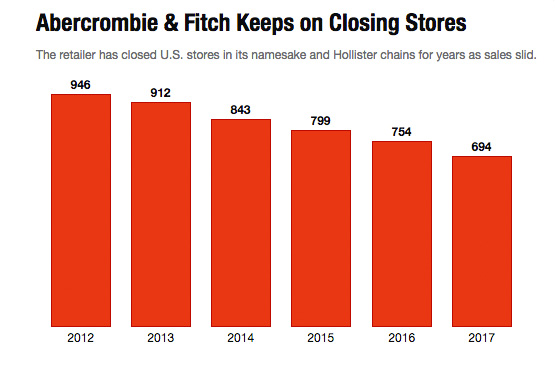
Image via Fortune, source Abercrombie & Fitch filings
3. High Profile Dishonesty
Just one untruthful comment by one top executive can negatively affect a brand. This can be particularly disruptive for service brands where the emphasis is on people. A renewed brand promise will help get things back on track.
A Canadian-based digital strategy specialist writes, “Brands aren’t heartless, mindless, soulless, brick and mortar stores. They are built by people. And no customer wants to associate with brands that comprise of unscrupulous, unreliable people. Honesty is always number one on buyers’ desirability index.”[10]
Example: After a 22-year career, NBC’s former national news anchor, Brian Williams, lost his job after exaggerating a report about his experience on the front lines in Iraq.
Result: With a quick response from NBC, a Williams apology, and a seven-month suspension for its news anchor, the network weathered the storm around trustworthiness. The popular news announcer who had enjoyed a 10-year, $15 million/year contract was brought back on air, albeit with a demotion to the network’s related cable brand, MSNBC.[11]
4. Broken Brand Promises
In the consumer’s mind, Whole Food stands for healthy eating, responsibly grown, and high quality standards, so that shoppers can buy with confidence around issues they care about.[12] A series of giant consumer let downs have occurred. Whole Foods Market, Inc. is big enough to fund their own newly hired full-time professional global VP to handle post-crisis brand strategy.[13]
Example: Whole Foods dropped the ball on their own brand promise. Last year, Whole Foods was found guilty of price mischarging from California to New York. In another salvo at Whole Foods in June 2016, the U.S. Food & Drug Administration issued a series of safety standard warnings[14] regarding fundamental cleanliness standards.
Result: Consumers were unimpressed when Whole Foods responded with a video from the company’s CEOs. People reportedly found the performance insincere, punctuated with the kind of overt gesticulation that students of body language are trained to spot. No discount was offered to entice customers back. Share prices for Whole Foods Market, Inc. have depreciated 25 percent in 12 months[15] and they’re pivoting to an ancillary brand, a smaller store with less selection, called 365, aimed at Millennials.[16]
What happened to “The Customer is Always Right”? Harry Gordon Selfridge may have overdone customer service with that mantra back in 1909. However, when a business’s explanation is open to interpretation as “we’re sorry we got caught,” you can be sure that savvy consumers aren’t buying it.

Image via YouTube
5. Scandals
When internal and external brand values are out of alignment and don’t match, the result can be devastating. FIFA, Volkswagen, Sports Direct, Chipotle, Bill Cosby, Ryan Lochte. And now Wells Fargo, one of the world’s largest banks (with a comfy Old West stagecoach brand image) was fined $185 million and released 5,300 when a fabricated bank account scandal broke.
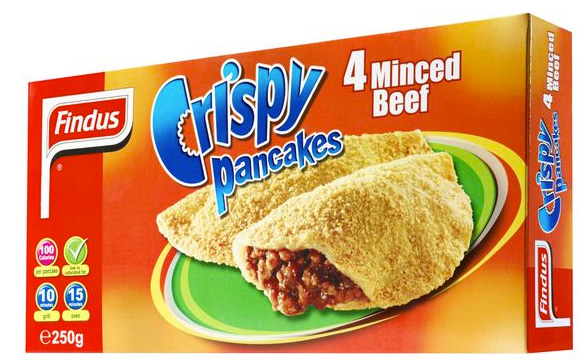
Image via Mirror UK
Example: For Findus, 50 years in the UK grocer’s frozen food aisles, it was one scandal too many. Following the uproar of 2013, when the beef lasagne was found to contain 60 to 100 percent horse meat, the product was pulled and the brand was sold. Time did not heal, as it became known that the brand had been served in 2,300 schools, hospitals, prisons, armed forces and senior housing,
Result: From spring 2017, the Findus brand is no more.[17]
Are you struggling with how to reposition your brand, rebuild your brand values, improve your brand promise — make your brand standout for the right reasons so it’s memorable and distinctive in ways that make it much loved? Then the Personality Profile Performer™ online programme is a perfect fit for you. Enroll today and make your brand highly visible and loved.
Questions to ask while reinforcing or rebuilding your brand:
• How strong is your brand reputation?
• What problem does your brand solve for its customers?
• Are your brand values clearly defined and communicated?
• How does your brand deliver on its promise?
• How do your employees, partners, vendors, suppliers and owners view your brand?
• When was the last time you conducted a brand audit?
[1] http://blog.ebiquity.com/2015/07/why-it-pays-to-take-the-drama-out-of-a-crisis
[2] Bendel, Peggy. “It’s a Crisis! Now What?” SutherlandHousePublishing.com, 2012.
[3] http://lexicon.ft.com/Term?term=brand-crisis
[4] http://blog.ebiquity.com/2015/07/why-it-pays-to-take-the-drama-out-of-a-crisis
[5] http://www.wsj.com/articles/SB112666533279540108
[6] http://www.ikea.com/us/en/about_ikea/newsitem/062816-recall-chest-and-dressers
[7] http://www.ikea.com/us/en/about_ikea/newsroom/product_recalls
[8] https://yougov.co.uk/news/2016/07/06/ikeas-drawer-debacle-wont-destroy-uk-image/
[9] https://mic.com/articles/130147/researchers-are-now-able-to-measure-just-how-embarrassing-an-uncool-brand-is#.T70A15Xkv
[10] http://www.business2community.com/branding/4-reasons-dishonesty-can-kill-brand-faster-bad-strategy-01084600#5XME1zbb2yep2m34.97
[11] https://www.washingtonpost.com/lifestyle/style/at-long-last-brian-williams-is-back–humbled-and-demoted-to-low-rated-msnbc/2015/09/21/ea423408-6077-11e5-b38e-06883aacba64_story.html
[12] http://www.wholefoodsmarket.com/mission-values
[13] http://www.vanityfair.com/news/2016/09/brooke-buchanan-theranos-whole-foods
[14] http://www.fda.gov/ICECI/EnforcementActions/WarningLetters/2016/ucm506089.htm
[15] http://www.investopedia.com/articles/markets/062016/what-whole-foods-latest-woes-mean-stock-wfm.asp
[16] http://money.cnn.com/2016/07/27/investing/whole-foods-earnings-july
[17] http://metro.co.uk/2016/01/31/goodbye-findus-crispy-pancakes-brand-dogged-by-horsemeat-scandal-is-to-disappear-5654449/
How to Transform Your Brand and Increase Your Sales
/0 Comments/in Brand Differentiation, Brand Leadership, Brand Personality, Brand Positioning, Brand Profiling & Positioning, Brand Revitalisation, Brand Strategy, Branding, Branding Bootcamp, Branding Masterclass, Branding Mastermind, Branding Workshop, Business, Rebrand, Rebranding /by Lorraine Carter10 Branding Tips From Silicon Valley on How to Be a Successful Startup Brand
/2 Comments/in Brand Positioning, Brand Profiling & Positioning, Brand Promise, Brand Relaunch, Brand Revitalisation, Brand Story, Brand Strategy, Brand Values, Brand Voice, Branding, Entrepreneur, Rebrand, Rebranding /by Lorraine CarterFrom Silicon Valley to Silicon Docks and Silicon Roundabout, the buzzwords “entrepreneur”, “branding” and “startup” get bandied about quite a bit, so let’s take a look at their meanings. Dictionary definitions indicate that an entrepreneur is a person who initiates, organizes and manages a business and assumes its risk. A startup is the vehicle for doing so and branding is what makes your brand highly visible, different, memorable and much loved. Underlying the definition in common use today, is that an entrepreneur has a vision for a new brand, a startup that will disrupt a particular practice.
Entrepreneurship is “creative, disruptive innovation,” as notably coined by the early 20th century economist Joseph Schumpeter.
A century later, a newer definition, courtesy of Silicon Valley-based investor Reid Hoffman[1], is: “An entrepreneur is a person who jumps off a cliff and builds a plane on the way down.”
 Image via Gapingvoid, © Hugh MacLeod
Image via Gapingvoid, © Hugh MacLeod
Branding From the Beginning
Startup brands in our commercial midst are actually nothing new. In fact, branding has been central to the success of innovators from the beginning. For centuries before modern society’s computer chip lent Silicon Valley its moniker, startups have been an essential part of the economy, picking up steam — to coin a phrase — during the Industrial Revolution. In the Information Age, entrepreneurship accounted for 14 percent of all working-age Americans in 2015, some 27 million people, in the USA alone. [2]
Startup Brands Are Still Brands
Startup brands are brands, just like established ones, only less developed. And, a branding professional who has been down this road many times can provide all-important markers for you in trailblazing the way ahead for your new brand. You’ll want to avoid brand mistakes that will likely require a costly do-over in time. Our Personality Profile Performer™ Programme is designed to guide brand owners and managers to build a highly visible, different, memorable and much loved new brand from scratch.
From birth you need a memorable name, a mission statement, a brand promise, a standout brand personality and a strong brand strategy prior to a brand launch. No one will debate that creating a startup brand isn’t hard work. We’re here to help!
Whether it’s the first sewing machine, a craft beer, or a new messaging app, being a founder is all-consuming…and always starts small even when you are thinking big.
What Is and Is Not Your Brand
The adage, “Everything is your brand and your brand is everything,”[3] as it appears in the pages of the Harvard Business Review, is true enough. However, until and unless you have your brand’s core values and the building blocks of your brand foundation in place, it is premature to take the next steps.
Your logo is not your brand. Your clever new dot.com name is not your brand. Your website is not your brand. Your packaging is not your brand. These are components of your brand to reflect your purpose and value.
Also, your place of business is definitely not your brand. Even a billion dollar brand can start in somebody’s garage…and they certainly have:
- Disney in 1923
- Hewlett Packard in 1939
- Apple in 1976
- Amazon in 1994
- Google in 1998
Essentials for Startup Brands and Branding
As an entrepreneur, YOU are the voice and visionary of your brand, you embody your brand and your passion shows. Seasoned Silicon Valley startup pros offer plenty of free advice for today’s entrepreneurs.
One of the key takeaways on perspective comes from Dave McClure[4], the straight-talking co-founder of 500Startups, a Silicon Valley startup accelerator and global investor. Here, McClure is describing the best way to make an elevator pitch for funding — yet the essence of his advice is spot-on for the strategic approach to building the foundation of a startup brand. He counsels:
“Here’s the secret: Pitch the problem, not the solution.”
“Just tell me the problem FIRST, not the SOLUTION. The reason is, I may not be able to understand what your solution does, but if you connect emotionally with me on what the problem is — and hopefully I also have the problem, or know someone who does — then I’ll give you PERMISSION to tell me more about how you’re going to solve the problem.” |
Ten Essential Startup Branding Tips
Here we take a look at 10 essential startup branding tips with comments from a dozen or so outstanding innovators and advisors from the Silicon Valley dot.com frontier.
- Amazon founder Jeff Bezos
- Lynda co-founder Lynda Weinman
- Linkedin co-founder Reid Hoffman
- Microsoft founder Bill Gates
- YouTube CEO Susan Wojcicki
- Apple founder Steve Jobs
- Media personality Oprah Winfrey
- Intuit co-founder Scott D. Cook
- Venture capitalist Matt Turck
- High tech investor Ben Horowitz
- Hewlett Packard CEO Meg Whitman
- Facebook founder Mark Zuckerberg
- Facebook COO Sheryl Sandberg
- SpaceX and Tesla founder Elon Musk
- Winner of Ireland’s Best Young Entrepreneur 2015 and “Best Start-up Award” at Google’s Dublin HQ, 24-year-old James Foody, now San Francisco-based
Tip #1: Building Your Brand
“You don’t know what you don’t know.” – Oprah Winfrey at a 2014 Stanford University Graduate School of Business interview.[5] |
Don’t try this alone. Silicon Valley wisdom counsels that even a genius cannot create a successful startup brand alone. No single person can possess all the required skills and have all the tools in their shed. Consider co-founders and advisors to move your business and branding strategy forward in the right direction. Remember…the “Fifth Beatle” for the Fab Four was their manager.
“My model for business is The Beatles. They were four guys who kept each other’s kind of negative tendencies in check. They balanced each other, and the total was greater than the sum of the parts. That’s how I see business: Great things in business are never done by one person, they’re done by a team of people.” – Steve Jobs |
TechCrunch, a San Francisco, Silicon Valley media platform, says mentors are the secret weapons for a successful startup brand.[6] Their study shows that “mentors who had already achieved success in the tech industry were able to help younger tech startups outperform their peers by a factor of three.”
Broadlake, in Dublin, models their whole philosophy on a very hands-on approach as both advisors, mentors and investors who invest their time and capital to help entrepreneurs succeed.
“There’s always new challenges and I think with new challenges we gotta switch on, we gotta engage, we gotta work with these teams and try and achieve often for what these ambitious growing companies are looking to do, which is ground breaking stuff.” – Pete Smyth, Broadlake |

Image via Broadlake
“Everyone needs a coach. It doesn’t matter whether you’re a basketball player, a tennis player, a gymnast, or a bridge player.” – Bill Gates |

Image via Stanford University
Tip #2: A Brand is Not a Logo
Brands are not solely visual. Your new brand is about how you make people think and feel about your product or service. The most common misperception out there among startups is from those who think their brand is about their logo and not much else! CEOs, owners, partners, investors and founders should not make this mistake…nor should designers.
“Your brand is what people say about you when you’re not in the room.” – Jeff Bezos |

Image via Slideshare
A side note: When Marissa Mayer was appointed new CEO of a struggling Yahoo in 2013, a new logo was among the first tasks undertaken by an internal committee. Meantime, email customers were unhappy with their service.
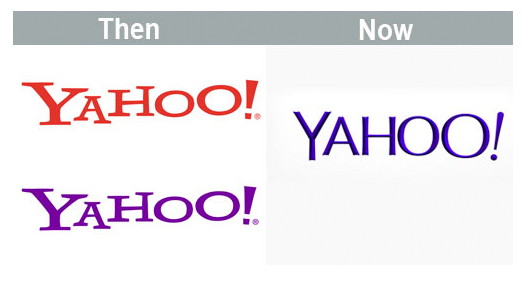
Image via Naldz Graphics
Lesson: When Yahoo skipped the brand audit they ended up with a deep customer disconnect that was never regained. [7]
The Yahoo backstory to date:

Image via Twitter
Tip #3: Build Brand Trust
As a founder, you are the embodiment of your brand both internally and externally. From the moment you interact with your first core users, trust is critical. Your company may grow, but brand trust is a constant.
“Google is a consumer company and our success is directly linked to our users trusting us.” – Susan Wojcicki |
And when you hire, make sure you hire the right people to personify the brand in its infancy. It is absolutely critical that your brand is represented properly all the time.

Image via Twitter
“If someone likes you they will listen to you. If someone trusts you they will do business with you.” – James Foody, Ayda |
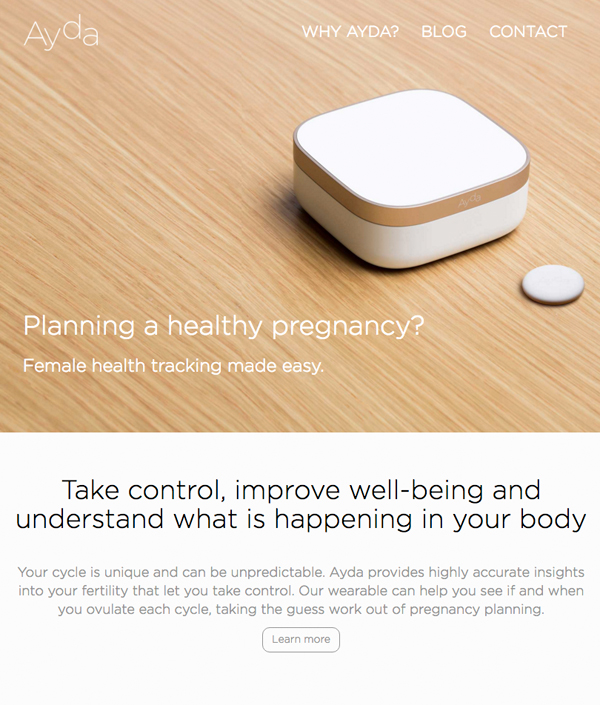
Image via Ayda
Tip #4: Identify Brand Need
When Lynda Weinman started teaching web design in 1993, she went in search of a textbook. All the books she found were too technical for beginners. (You can probably see where this story will lead.)
“I remember thinking maybe this book doesn’t exist yet. I went home from the bookstore and wrote the book proposal.” – Lynda Weinman |
It was early days on the internet in 1995 when Lynda then got the idea to move her reference materials online and create a teaching course around them. Two decades later, Weinman had earned the nickname, “Mother of the Internet.”[8]
In the spring of 2015, Lynda Weinman sold her company, Lynda.com, to LinkedIn for $1.5 billion. The new owner, the world’s premier business-oriented social networking service, was seven years away from its own founding when the brand Lynda.com was created.
Tip #5: Become a Brand Guru
Once you’ve identified a passion, become an expert in whatever it is. Tell your story well. In the brand’s early days, you need anecdotes, not raw data. Be authentic, be enthusiastic, be clued up and know your stuff. Your brand promise must be frequently voiced, relatable, and completely transparent.
“Whether you are interacting with customers, fundraising or recruiting, you are always selling and, and the best salespeople are master storytellers. Craft a compelling and genuine company story that resonates with your audience not just intellectually, but also emotionally.” – Matt Turck, Venture Capitalist, FirstMark Capital |
Tip #6: Determine Brand Positioning
“A brand is no longer what we tell the consumer it is — it is what consumers tell each other it is.” – Scott D. Cook |
Your core customers are your sounding board — an important audience for a startup. Is your brand positioning clear? Customers want companies to listen to their opinions, so you’ll need feedback to guide you in shaping your brand position in the marketplace. Before you can concern yourself with traction and loyalty, you need to ensure that the brand resonates, fills a need, and has value. Get feedback at every iteration along the way to ensure you’re moving in the right direction for consumer wants and needs. Tweaks will be necessary.
“Another one of my favourite posters at Facebook declares in big red letters, “Done is better than perfect.” I have tried to embrace this motto and let go of unattainable standards. Aiming for perfection causes frustration at best and paralysis at worst.” – Sheryl Sandberg |
Tip #7: Communicate Your Brand
It can be difficult to properly communicate your startup vision to others. But, it’s critical that you do so effectively.
Keep lines of communication open constantly and force yourself to listen to critics. Learning how to manage people takes work. But if you don’t learn how to communicate, you risk destroying relationships with customers and employees.
“As a company grows, communication becomes its biggest challenge.” – Ben Horowitz |
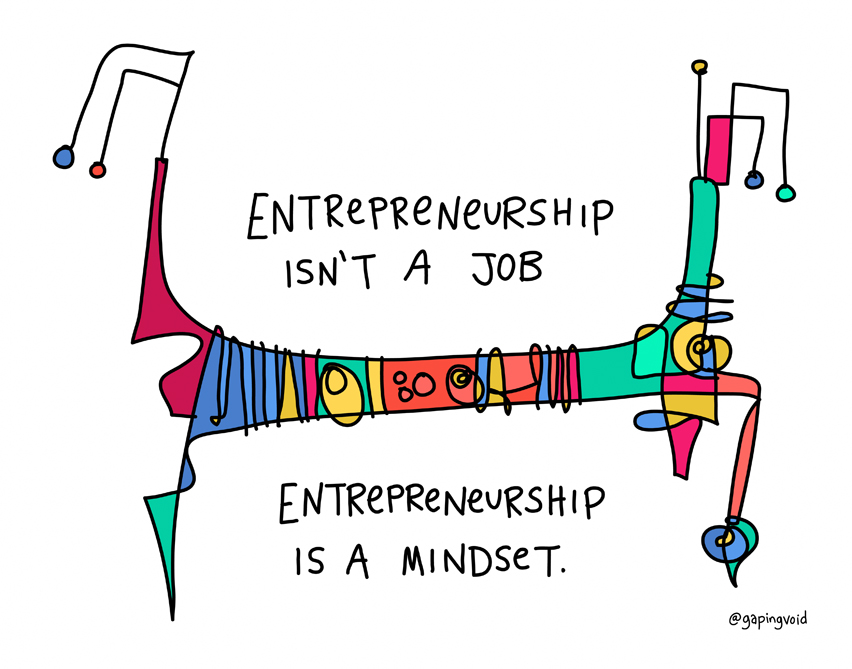
Image via Gapingvoid, © Hugh MacLeod
Tip #8: Delight Your Customers
Bill Gates says the one word that best describes the startup mindset is optimism. Self-made multi-billionaire Warren Buffett says “At 85, I tap dance to work every day.”
Have fun and the pleasure of doing business with you will show right across your startup brand. Even if your brand is about heavily scientific based inter-planetary colonization, like SpaceX founder Elon Musk, let your good humour shine through.
“I would like to die on Mars, just not on impact.” – Elon Musk |
“Fun is at the core of the way I like to do business and it has been key to everything I’ve done from the outset. More than any other element, fun is the secret of Virgin’s success.” – Richard Branson |
Tip #9: Believe in Your Brand
Perseverance is the name of the game. Believe in your vision. Remember the lesson from a 30-year-old Steve Jobs when he got fired from the company he founded…it’s OK to fail. So be brave, take risks, learn from them, and don’t give up if you love what you do.
Passion will keep you going when you get hit in the head with a brick, which will only make success taste even sweeter.
Fact: A startup brand will experience setbacks.
“See criticism as free learning that makes you a better entrepreneur. Don’t be constrained or deflated by criticism, but do learn from it.” – James Foody |
Tip #10: Nurture Your Brand
Once you’re certain your startup brand is is ready for launch, keep your vision focused on the moonshot…the thing that people may not think is possible could be within your reach. Listen to your inner GPS and let it guide you on the ride of your life.
“Picking what problem to go and solve is a much bigger and more important challenge than being able to solve the problem.” – Mark Zuckerberg |
“When people use your brand name as a verb, that is remarkable.” – Meg Whitman |
Ask Yourself…
- Are you developing a new brand to launch to market but you’re just not sure where to start to ensure a strong financial return? Our “Personality Profile Performer”™ course is perfect for you.
- Have you got an existing brand but it’s just not strong enough to make it to No.1 in the market? Talk to us about how we can guide you to build your brand recognition plan.
- Have you underestimated how difficult a startup brand really is? Or, perhaps you’re not dreaming big enough. We can help you with a branding strategy to ensure that you are properly positioned.
- Are you struggling with your brand story? Let us help you craft a compelling one in your brand’s own tone of voice.
- Does your brand identity need a boost? We can consult with you on everything from font to packaging design.
- Have you attempted a startup that missed its mark? We can help you revitalize and relaunch a product or service to get the result you’re looking for.
[1] https://www.linkedin.com/today/author/1213
[2] http://www.inc.com/leigh-buchanan/us-entrepreneurship-reaches-record-highs.html
[3] https://hbr.org/2011/06/a-logo-is-not-a-brand/
[4] https://www.linkedin.com/in/davemcclure
[5] https://www.youtube.com/watch?v=6DlrqeWrczs
[6] https://techcrunch.com/2015/03/22/mentors-are-the-secret-weapons-of-successful-startups
[7] http://www.inc.com/cody-steve/yahoo-logo-redesign-marissa-mayer.html
[8] http://bit.ly/2aj9GDW
Rebrand or Refresh? That is the Question
/0 Comments/in Brand Audit, Brand Auditing, Brand Audits, Brand Culture, Brand Differentiation, Brand Personality, Brand Profiling & Positioning, Brand Revitalisation, Branding, Professional Services, Rebrand, Rebranding, Revamped Design, Revitalized Design, Uncategorized /by Lorraine CarterA Rebranding Strategy Guide for Brand Owners and Managers
The business world is in a constant state of flux. Markets change, new trends emerge, disruptive competitors alter longstanding rules, and customer preferences evolve — all of which impacts your brand. Consequently brands are constantly evolving to ensure future growth and relevance. Even the longest standing and greatest brands in the world need rejuvenation, if not a total rebrand, in order to maintain their market leadership.
Like the foundation upon which a house is built, a strong brand is essential, indeed it is the lifeblood for any successful organisation. When cracks appear in that foundation, a wise owner or manager must take action to repair, introduce procedures to prevent deterioration and take steps to strengthen the brand for future growth. Experts say that organisations and brands change their corporate identities on an average of once every 7-10 years. [1]
On a regular basis, diligent brand owners and managers need to take a step away from an organization’s day-to-day operations to examine and re-evaluate their position and strength in the market. If your brand isn’t achieving its objectives or driving business growth, there’s little time to be lost wondering what to do about it. Its time to give your brand a health check. Frequently asked questions about the two brand revitalisation routes include:
- What’s the difference between a brand refresh and a rebrand?
- How do I determine which one is the most suitable choice?
Rebranding or revitalization can take many guises from the complete wholesale change of a company, service or product, inside and out, including; name, culture, values, vision, mission, proposition, positioning, purpose, behaviours, tone, visual collateral and all that entails with no connections to the legacy entity. Alternatively, it can be something less dramatic and of a more subtle, evolutionary nature in the form of a brand refresh.
In each instance though, the change to whatever degree, be it a total rebrand overhaul or brand refresh, affects a change in the minds of the target audience in terms of their perceptions of the brand. That change is a process of giving an organisation, product or service a new meaning and image, both in terms of brand experience and culture to its visual brand collateral, in order to make it more successful.
In determining whether it’s time for a refresh or a rebrand, one of the most effective tools for re-assessing your brand’s state is a brand audit health check to examine external and internal drivers that impact your brand. Like any checkup, a brand audit is best done as a proactive and preventative measure. Aside from determining the health or state of your brand, a brand audit also helps determine the level of potential change required — to rebrand or refresh.
“A brand audit is effectively a health check of your brand to identify and address problem areas with a net result of helping you turn things around and grow your bottom line.
Brands are like living entities with life cycles. They start with much excitement and promise, grow and then eventually plateau. A brand audit helps you innovate, re-invent, re-invigorate, and ensure market leadership and continued relevance so you can maximise your commercial return and fend off your competition.
The scale and depth of a brand audit is largely determined by your primary objectives coupled with timelines and resources.”
What’s the Difference between Refresh and Rebrand?
The reasons for rebranding and or refreshing an organisation, product or service are numerous and decisions should not be taken lightly without sound strategic reasons before launching into the process.
Once you know why you’re considering either a rebrand or refresh and what your primary objectives are in making this strategic decision, consider the following differences:
Rebrand or Refresh? A Quick Reference Checklist
| Refresh | Rebrand |
| What: Expand reach and market impact, get new customers, attract new talent, increase profitability
Why: Declining market share, diminishing growth, changing client’s or customers needs, tired and dated with lack of brand relevance, insufficient new leads, significant new product/service launch, lack of brand distinction, entering a new market, aggressive new competitors, new technology changes, struggling to describe what makes your firm, organisation, product or service different, difficulty attracting new talent, competitors poaching key employees, need to take your organisation to the next level, change in brand architecture or hierarchy | What: A re-positioning to change market perceptions, re-evaluate who are we, why do we exist? What’s our mission, vision, values, promise? How do we define and articulate our brand proposition and purpose? How is our brand really different to our competitors?
Why: New ownership, merger or acquisition, legal issues, reputation damage, rationalisation, outgrowth, globalisation, new primary target audience(s), competition, new sectorial challengers and disruptors |
| What: Evolutionary logo update
Why: Better reflection of brand platform and values | What: New brand identity
Why: To streamline and simplify or a complete change in core business |
| What: Evolve, update tagline
Why: Tweak the message, spotlight the business, stay current, introduce a new brand promise reflecting enhancements provided by the business | What: New tagline
Why: New line of business, new audience or an innovative advancement, new positioning |
| What: Health check your brand personality and primary characteristics using brand profiling — elements reference check
Why: Increased competition, slower sales, insufficient brand relevance and resonance, create enhanced distinction and market recognition, develop stronger brand resonance with customers | What: Redefine your new brand personality and brand characteristics
Why: Make it more relevant, engaging, compelling, distinctive, different, memorable and referable |
| What: Evaluate your brand promise and enhance consistent delivery
Why: Customer feedback, lack of strong distinction, difference and referability | What: Change your brand promise
Why: As a result of new products, services |
| What: Re-evaluate customer base versus profitability, evaluate brand equity
Why: Customer research, re-evaluate existing buyer personas (customer profiles) | What: New primary audience, need to change existing or previous customer perceptions
Why: Customer research, develop new customer buyer personas |
| What: Build new leadership and employee training modules
Why: People represent the brand and need the knowledge to be effective brand champions | What: Revamp leadership and employee training programmes
Why: To interpret and support company culture, develop new brand ambassadors |
| What: Expand market share
Why: Changes in competitive set and customer wants/needs | What: Find and capture new customers
Why: Change of price point and positioning |
| What: Introduce new products, services congruent with primary offering
Why: Business expansion within existing customer base and to attract new customers | What: Discontinue or retire some existing products, services
Why: Lack of market demand, no longer relevant, changing customer needs, competitors |
| What: Launch within a shorter timeline
Why: Competitive edge, attract change hungry customers, capture / maintain lead market share | What: Stage a rollout over a year or longer
Why: Extensive impact throughout the business, firm or organisation requiring change management internally and externally |
So, refresh or rebrand? Here we take a look at both options and evaluate the most significant or typical reasons for deciding to choose one over the other. We’ll also review several case studies and key learnings to be extracted.
Rebranding or Brand Refresh Process
Establishing the reasons behind any brand change is fundamental. Whether your brand audit points to a refresh or a rebrand, both routes require a process of due diligence to determine the changes required and to what degree. Both routes require an inclusive approach, from the C-suite to the newest team member, ensuring that everyone in the organisation sees themselves as an essential part of the brand.
Engagement with the external market, customers, stakeholders and influencers alike is also hugely important. There many examples of brands which failed to address this adequately and consequently suffered significantly at the hands of voluble detractors.
While it may be tempting to jump into the visual brand design aspects, the process of investigation, discovery, analysis and brand strategy development cannot be overlooked or rushed — at your brand peril.
Broadly speaking a typical rebrand or refresh process includes:
- Rebrand / refresh planning; timelines, resources, team
- Brand audit health check and research
- Brand profiling, architecture, differentiators and positioning documentation – update or overhaul
- Brand strategy development
- Brand design, messaging development and application
- Brand testing, research and refinement before implementation and rollout
- Brand induction and training throughout the organisation and external third parties
- Internal / external communications planning and rollout of rebrand or refresh
- Brand style guide development for protection and management of the brand
- Measure of impact and commercial return against previously determined key performance indicators
Are you struggling with how to make your brand highly visible, different, distinctive memorable and likeable? Take a look at the Personality Profile Performer™ Programme. It’s a step-by-step process to make your brand No.1 in your target market — especially if you’re a getting lost in the market amongst all your competitors.
Rebranding Strategy
Approaching a rebranding or brand refresh process without strategic planning, market insights and customer engagement can have disastrous consequences. The strategy leading to a brand refresh or to rebranding requires much more than changes to a logo; it requires an understanding of strategic objectives for the brand.
Research involves consultation with staff, with existing, lost and prospective customers, former clients, and competitor insights to get a full picture of current brand associations as well as customer perceptions, wants and needs.
Therefore, an investment in time for research and assessment is required to flesh out areas of strength and weakness and their impact on the brand to see whether a total rebrand or just a refresh is required. The brand audit will also typically reveal new opportunities and point the way towards what you need to do to leverage them for greatest impact.
Rebranding Deliverables
Define deliverables to the organisation. These typically include a brand positioning statement that summarises the pertinent research and brand profiling outputs regarding the unique selling points and key brand characteristics that set the brand apart and make it highly visible, different, distinctive, memorable and liked while also providing the roadmap or GPS direction for the brand moving forward.
Brand messaging is delivered to include some or all of the following: values, vision, promise and mission statement, brand story, value proposition (for aligning brand product and services to customer communications), identification of target audiences, development of purchaser personas and a key messages crafted for each. Deliverables might also include problem statements and problem solutions.
Lastly, the design aspect of visual and / or audio deliverables should be identified e.g. logo and a tagline, packaging, stationery, website, social media platforms, apps update or overhaul, brochures, uniforms, PowerPoint or Keynote templates, sales supports, vehicle livery, uniforms, signage, site interiors and exteriors, exhibition stands, possibly music, videos, and more. It’s critical that your new or revitalised brand collateral properly reflects your brand, is consistent throughout every touch point and most importantly reflects and amplifies your key brand differentiators and brand personality in a way that’s really meaningful to your primary audience.
Rebranding or Brand Refresh Rollout
To avoid miscommunications, a new or refreshed branding launch is staged first internally. An organisation must provide insights, education and training to everyone, top down from senior management to general employees to ensure they are onboard to advocate the new brand. Front line employees’ communications are essential to the successful external customer roll out which follows.
Top 15 Tips for Ensuring a Successful Rebrand or Refresh
- Consult management
- Conduct a brand audit
- Determine refresh or rebrand requirement
- Set objectives
- Establish a timeline
- Set budget appropriately
- Create a balanced project team internally and externally
- Evaluate all customer touchpoints
- Re-develop / overhaul brand proposition, positioning and differentiators
- Re-visit brand strategy; sales and marketing messages and channels
- Develop brand strategy, brand profiling documents to provide the essential brand directions or roadmap
- Develop brand design brief
- Commission brand design agency (with relevant expertise)
- Determine methodology and markers for measuring ROI
- Plan and execute brand rollout to market
Hit or Miss: Brand Refresh and Rebrand Examples
Taking the time and consulting the experts to get it right is critical; a miss can be a costly affair.
Accenture: Rebranding Involved the Entire Global Organization
Amid much fanfare, Andersen Consulting hung a huge banner at the New York Stock Exchange to announce its 2001 reorganization from partnership to public company and a rebranding as Accenture. Following arbitration involving accountancy Arthur Andersen, the new name (meaning accent on the future) resulted from an internal competition won by a Danish employee in the company’s Oslo office, chosen from 2,677 submissions from 42 countries.[2]

Image via Accenture
Time magazine pegged Accenture “as a generic corporate nonsense word only a management consultant could have come up with…“[3] Only this was not the case. Currently the world’s largest management consultancy, Accenture might have made more of the positive PR storytelling opportunity about the brainstorming naming contest and the winner’s inspiration.
Morgan, Lewis & Bockius LLP: A Leading Law Firm says Brand Audit and Teamwork Are Key to Rebrand Success
America’s largest law firm undertook a rebrand over a 15 month period. Morgan, Lewis & Bockius LLP had experienced two mergers, and the rebrand was intended to “define and raise awareness of our practice and industry expertise, commitment to client service, and seamless global reach.”
The brand audit health check process involved many thousands of pieces of content, including 2,000 lawyer biographies to be re-written, according to the firm’s chief business development and marketing officer. The takeaway? To “cultivate a really strong collaboration among all of the constituents responsible for launching a new brand…No single person could have accomplished this alone; this was truly a team effort.”[4]
Massey Bros.: One of Dublin’s Largest Funeral Directors Rebranded to Amplify its Brand Leadership Positioning and New Innovative Services
Massey Bros. Funeral Directors is a very successful family owned and managed business established in Dublin in the 1930s. They operate in a sector which is traditionally very conservative yet they’re industry leaders in terms of their premium service together with ongoing innovative solutions offered.
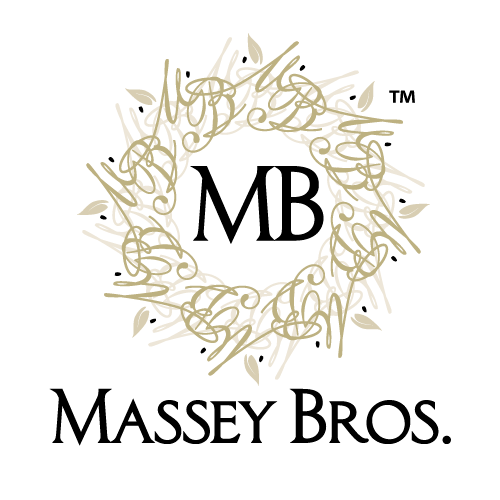
They also have the added complication of having more than six competitors also operating legitimately under the ‘Massey’ name. In addition to this they themselves also operated under two names before their brand refresh! Their brand revitalisation strategy helped them fully leverage their leadership positioning and amplify their multiple new innovative service solutions offered.
Dublin Tourism Board: Refreshes the Destination’s Strategic Positioning
Tourists have a finite number of vacation days and discretionary budget for holidays, so every destination competes to capture that spend. Visit Dublin undertook a study[5] to determine reasons for declining tourism numbers since 2007, resulting in a new positioning crafted to a visitor-focused strategy further analyzed by length of stay, reason for visit, country of origin and more demographics. As a 5-year plan, the realigned strategy, “A Breath of Fresh Air” gets buy-ins from the stakeholders and community to highlight both urban and outdoor visitor experiences.
Old Spice: Rebranded to Reposition – It Used to be on Your Grandfather’s Bathroom Shelf!
Marketing pros everywhere love the transformation of Old Spice[6] fragrance for men from an ageing brand to a sexy one. Aimed at a younger, newly targeted consumer audience, the “Smell Like a Man, Man” campaign (52 million views and counting) smells nothing like 1938, the classic brand’s year of birth.
Learn from these well-known rebranding and brand refresh failures, now text book case studies on approaches to avoid. The primary lesson in each of these examples is do your due diligence before rebranding or refreshing your brand!
Royal Mail:
Consignia was a £2 million investment launched in January 2001 for the U.K. postal service. Calling the new name, “Nine letters that spelled fiasco,”[7] the BBC joined others to prompt a U-turn to return to Royal Mail 16 months later.
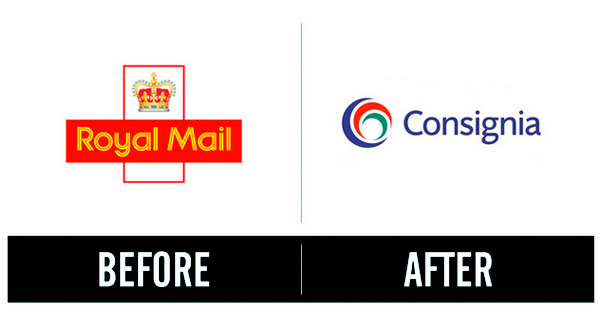
Image via Royalmail
Tropicana:
When parent company PepsiCo removed the leafy green logo and juicy orange pierced with a straw in favor of a one-dimensional glass of juice, Tropicana sales plummeted by 20 percent. On top of whatever the rebrand and reversal cost, sales suffered to the tune of $137 million between January 1st and February 22nd 2009.
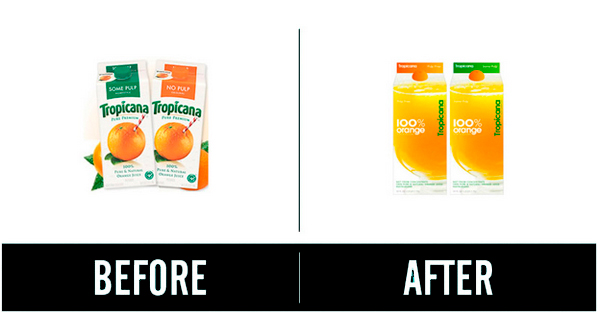
Image via Adage.com
Gap:
Perhaps the fastest rebrand turnaround ever, the new Gap logo lasted only six days at Christmas 2010. Consumer reaction was negative and outspoken. In going back to square one, the whole exercise has been estimated to have cost Gap $100 million.[8]
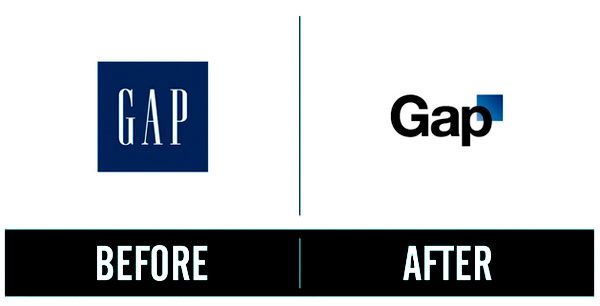
Image via Gap
RadioShack:
RadioShack, founded in 1921, once operated 8,000-plus retail locations around the world. In 2015, after 11 consecutive quarterly losses, RadioShack filed for bankruptcy. Instead of spending millions on a refresh as “The Shack”, the company needed to completely rebrand. Service in RadioShack was reportedly abysmal, selection regarded as limited, prices perceived to be high and the USP as an electronic supplier of parts was no longer considered relevant.
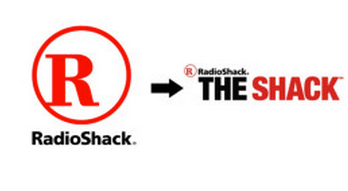
Image via RadioShack
Can we help you with your brand refresh or rebranding?
Ask yourself:
- Are you prepared to undertake a thorough assessment of your brand’s standing by giving your brand a thorough health check — a brand audit?
- Does your brand strategy plan reflect the time commitment involved in making a change?
- Has budget been allocated for a brand refresh or total rebrand?
- Have you identified strategic reasons for a brand refresh or rebranding?
- Is your brand still truly relevant to your target market now and into the future?
- Is your brand really distinctive, different and memorable from a customer/client perspective? Do you need to re-evaluate your brand profile?
- Are you considering a rebrand to solve a brand challenge and / or a commercial challenge?
- Have you really evaluated the impact of new disruptors and challengers entering your market and how your brand will compete against them?
You may also like:
- How Brand Purpose = Purchase = Increased Profitability
- Rebranding Strategy: Why Your Rebrand Must Embrace Storytelling
- Brand Flops: 5 Lessons Brand Managers Can Learn From Epic Brand Failures
- Brand Revitalisation and Relaunch: The do’s and don’ts of doing it successfully!
[1] VIM-Group.com
[2] https://newsroom.accenture.com/subjects/accenture-corporate/andersen-consulting-announces-new-name-accenture-effective-010101.htm
[3] http://content.time.com/time/specials/packages/article/0,28804,1914815_1914808_1914804,00.html
[4] http://www.infinitespada.com/news/what-it-takes-to-rebrand-americas-largest-law-firm
[5] http://www.failteireland.ie/FailteIreland/media/WebsiteStructure/Documents/4_Corporate_Documents/Strategy_Operations_Plans/Destination_Dublin_GDT_2020_Full_File.pdf?ext=.pdf
[6] http://www.personadesign.ie/blog/brand_resurgence_4_lessons_learned_from_amazing_brand_comebacks
[7] http://news.bbc.co.uk/2/hi/business/2002480.stm
[8] https://www.linkedin.com/pulse/million-dollar-branding-mistakes-from-pepsi-radio-shack-quinn?trkSplashRedir=true&forceNoSplash=true
About
Persona Branding & Design Consultants
Contact: Lorraine Carter
T: +353 1 832 2724
Carra House
Howth, Co. Dublin, Ireland
Copyright © 2007-2022 All rights reserved.
Persona Design Consultants Ltd.
Registered in Ireland: No. 201997
Member of


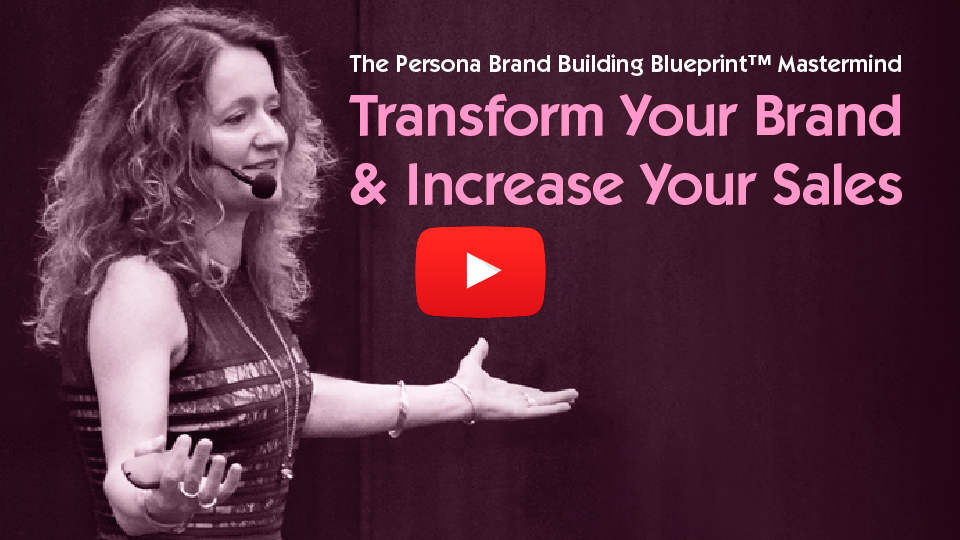
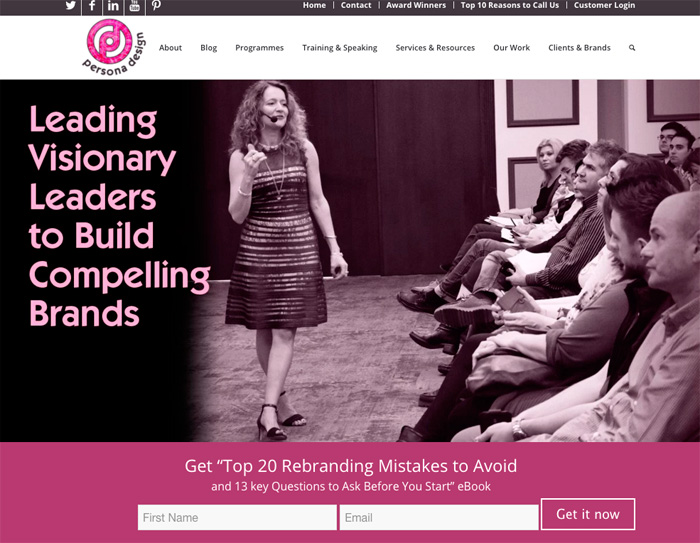
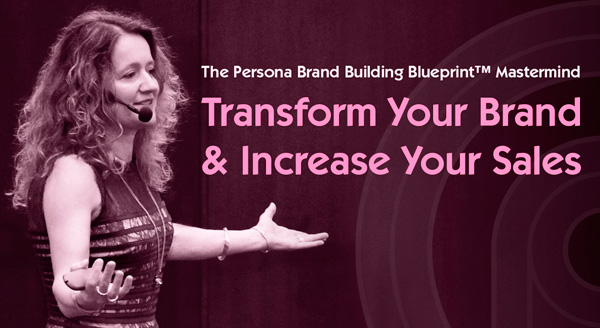



 Image via Gapingvoid, © Hugh MacLeod
Image via Gapingvoid, © Hugh MacLeod
